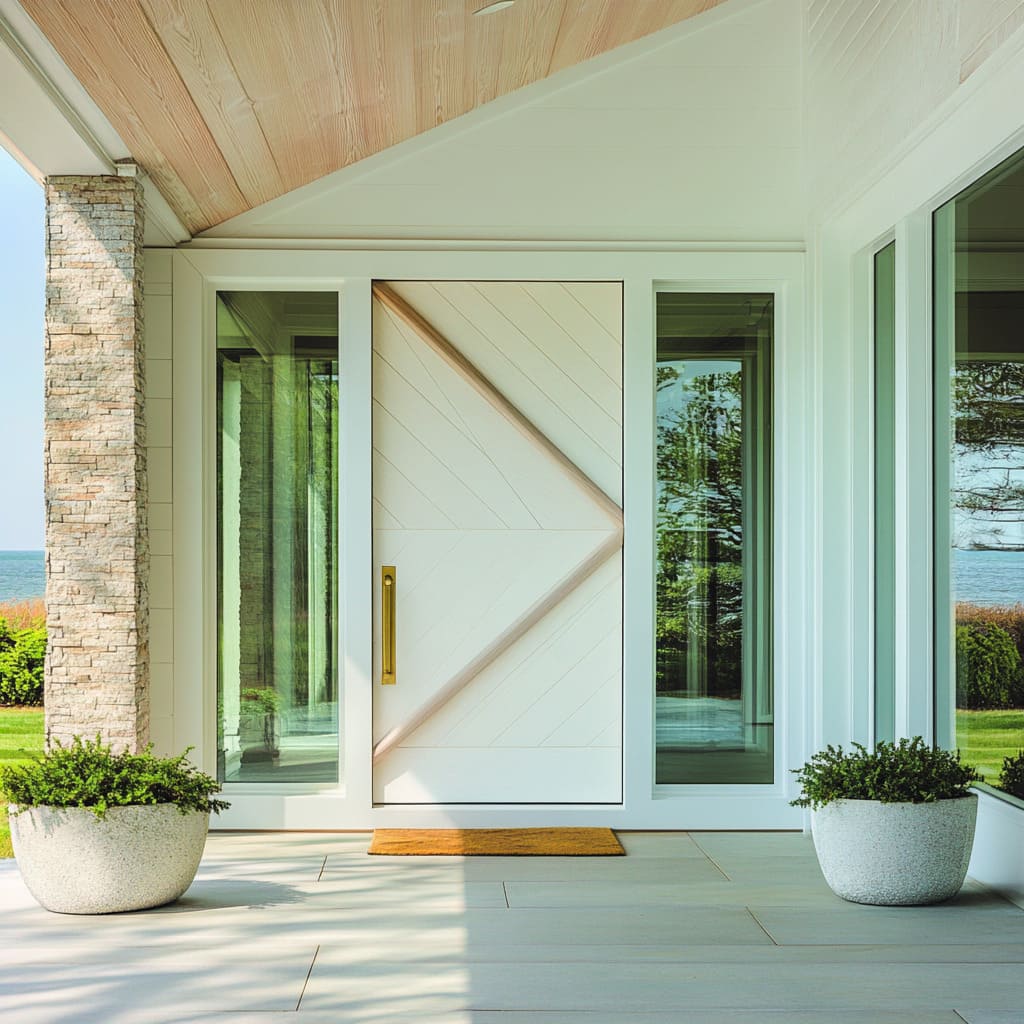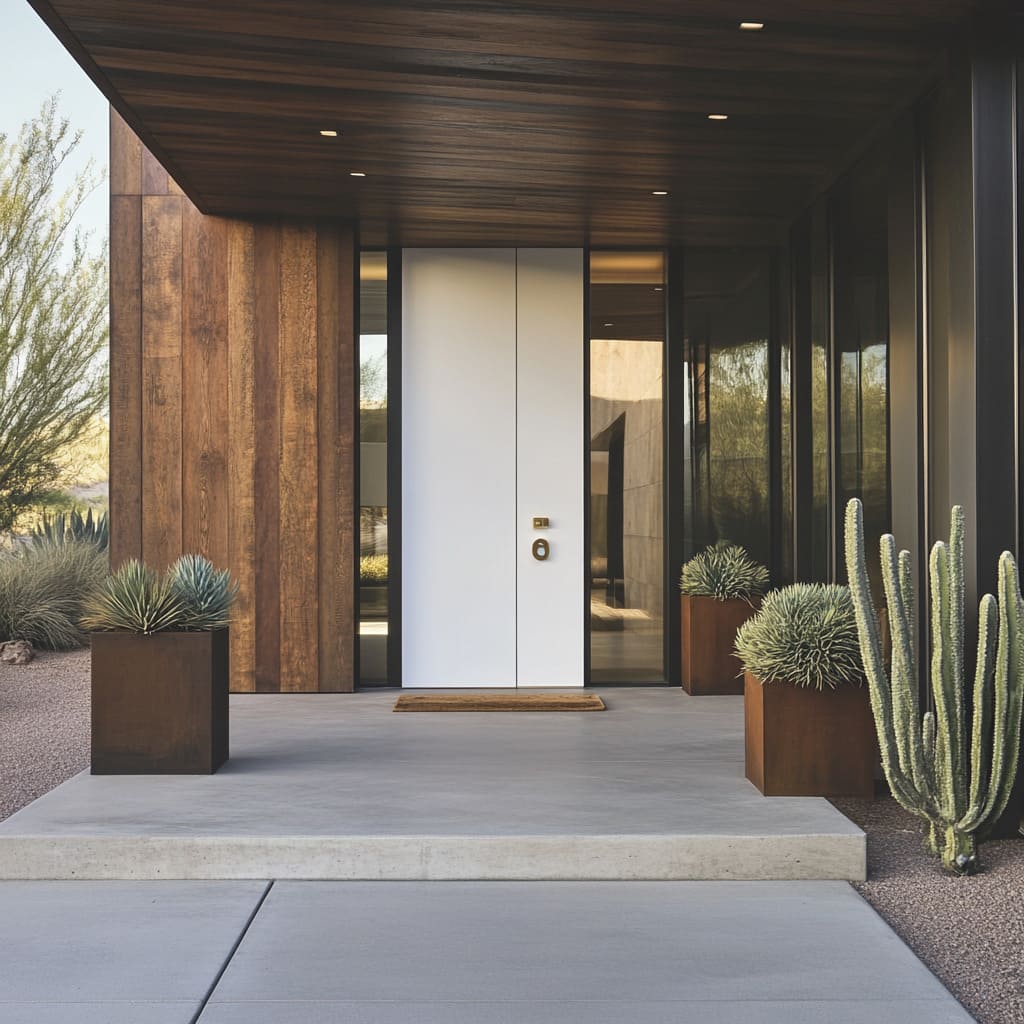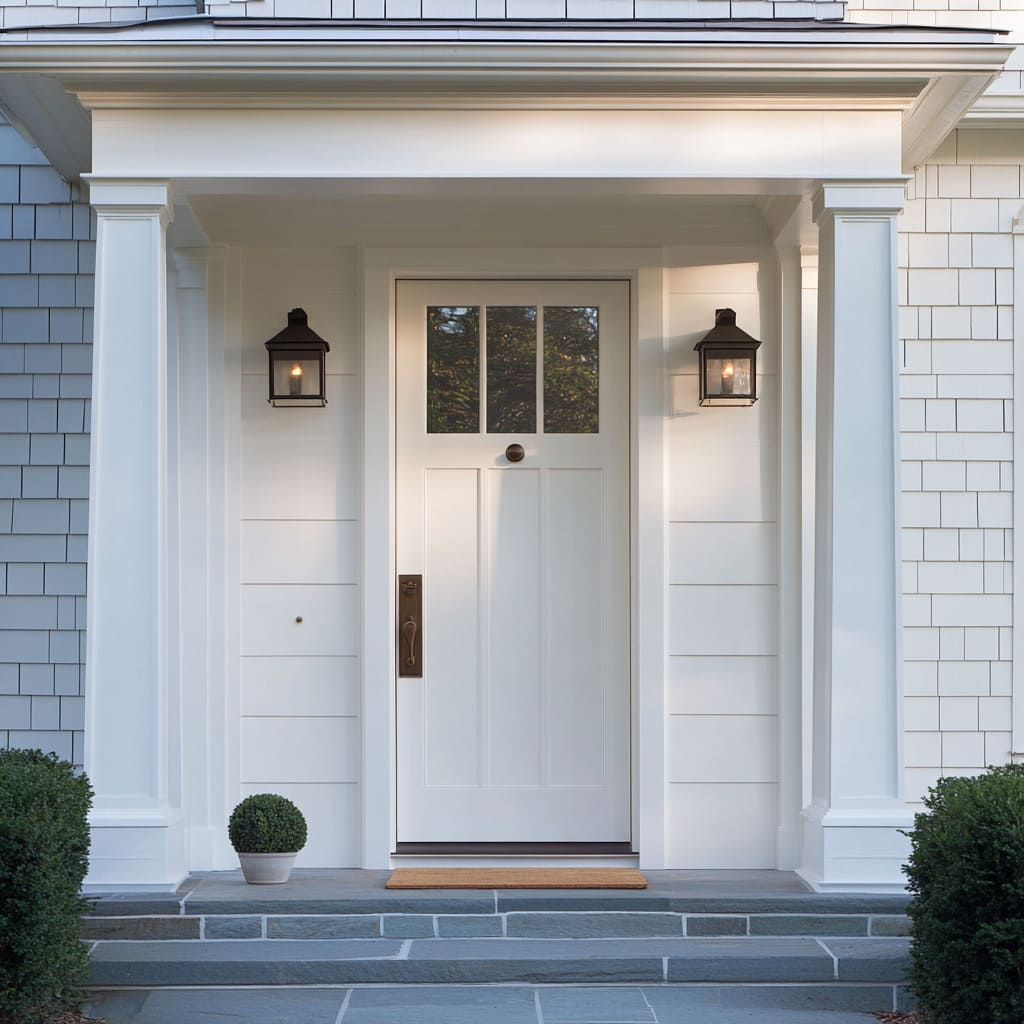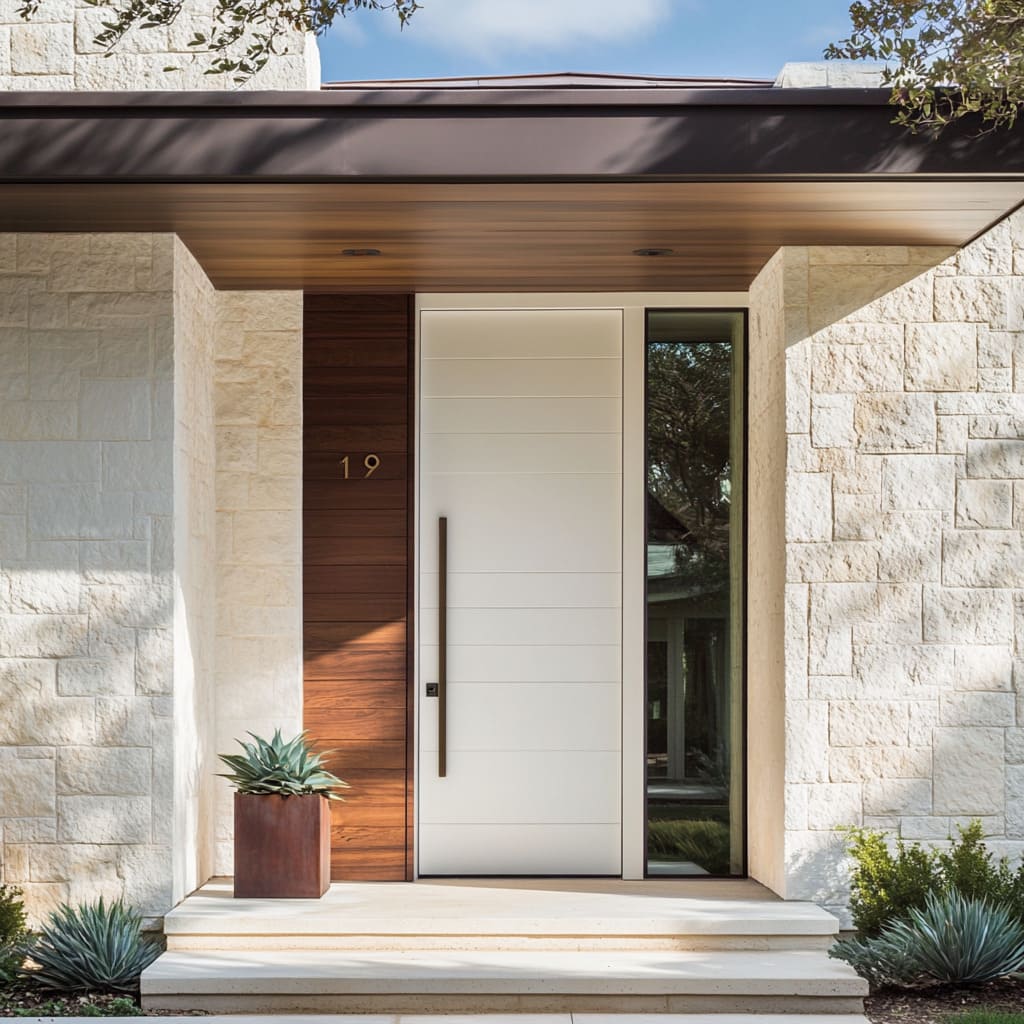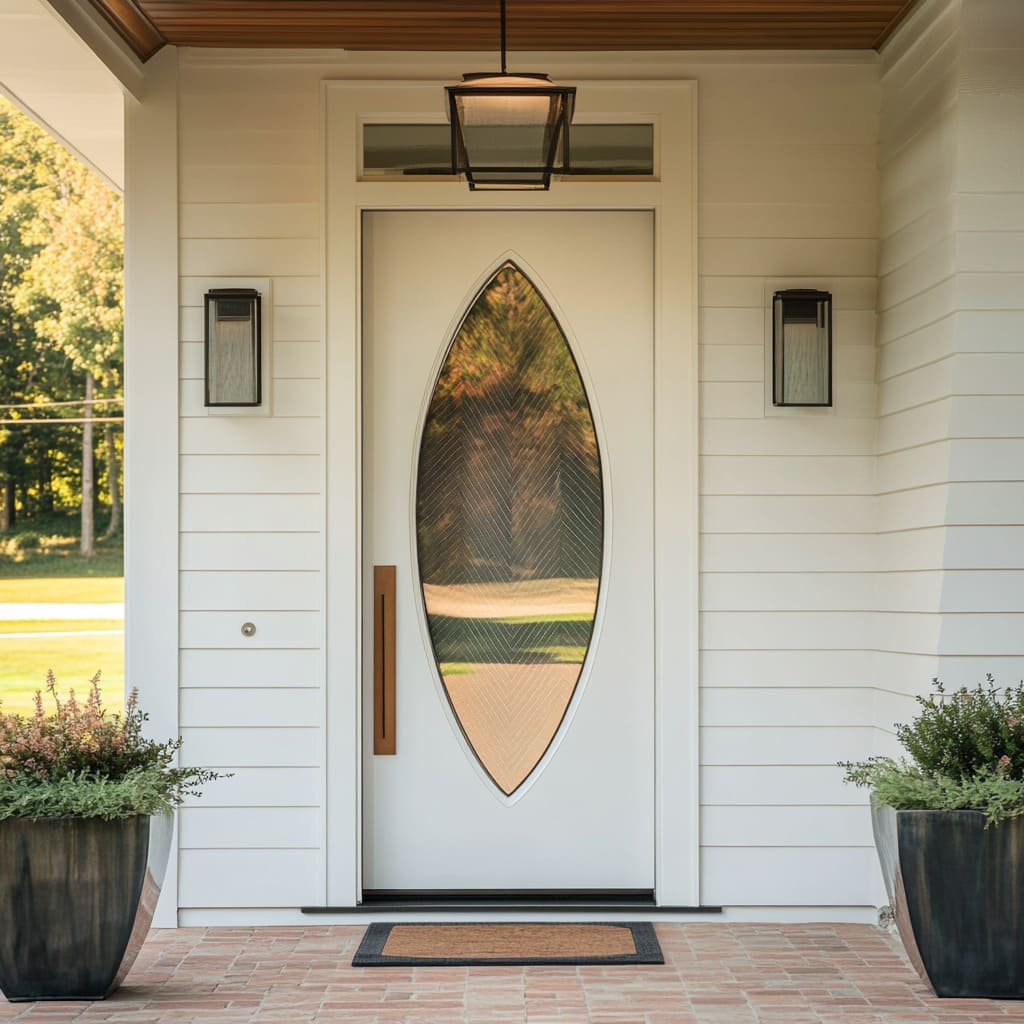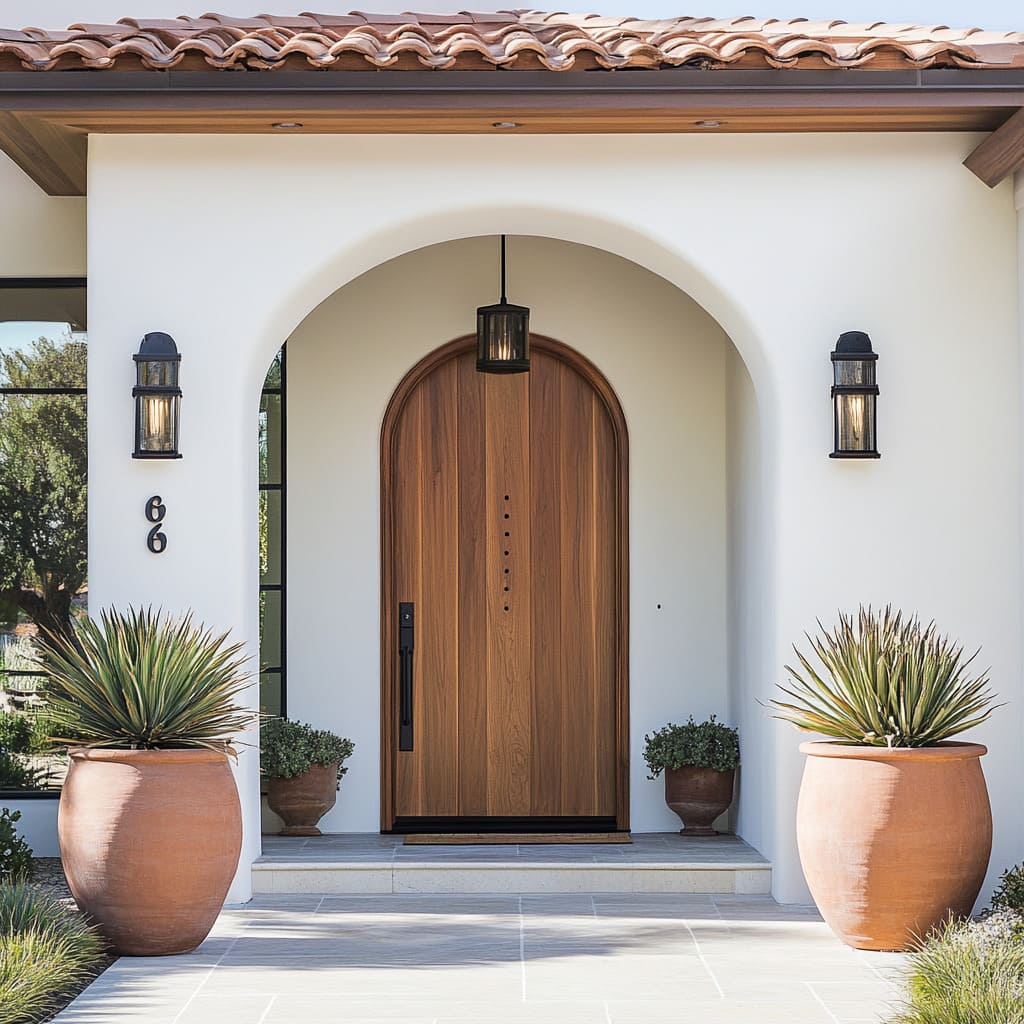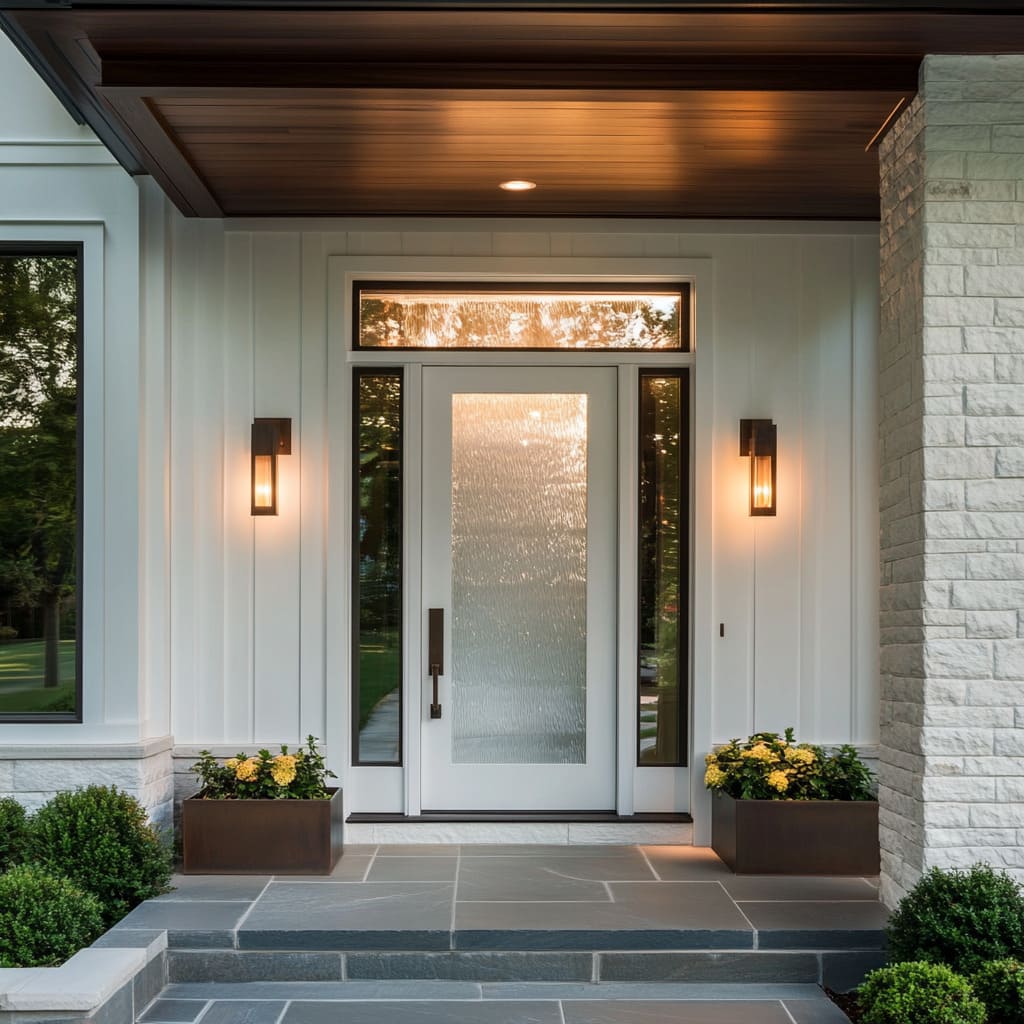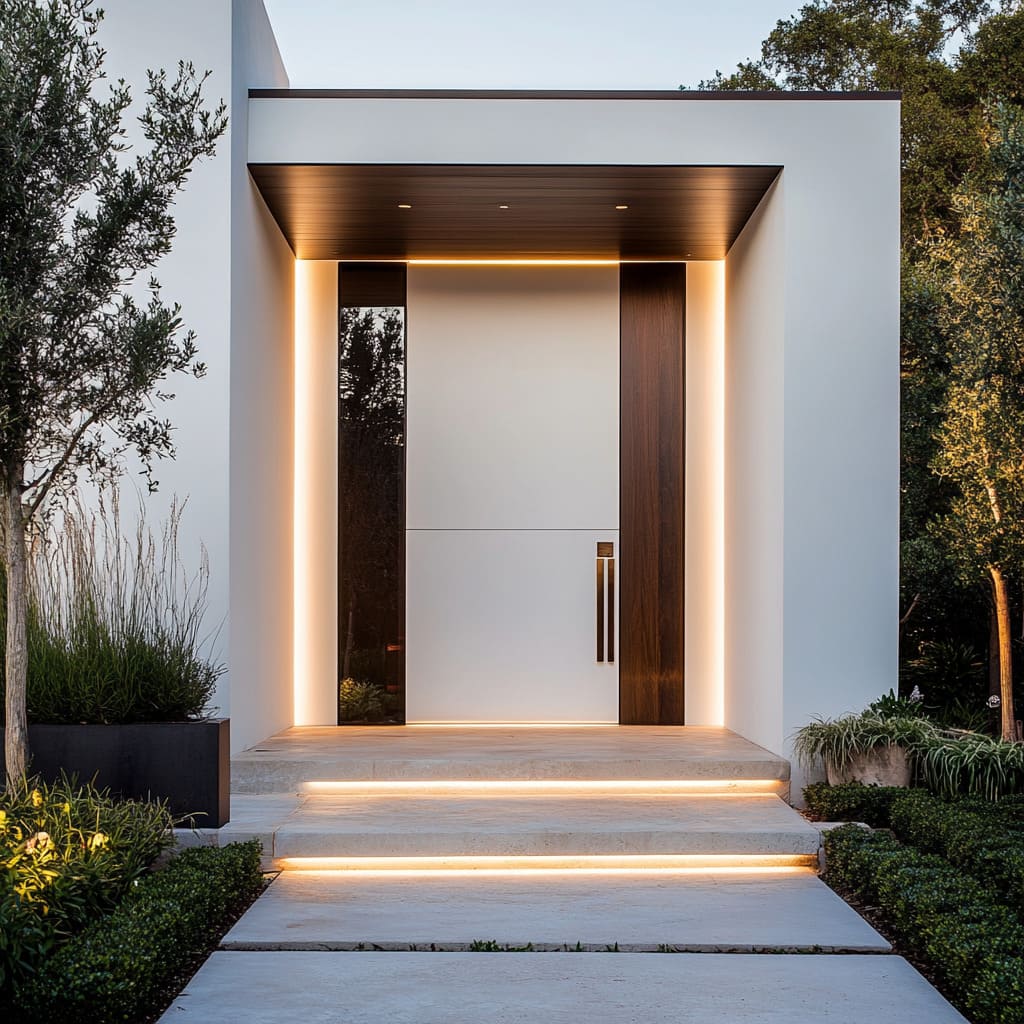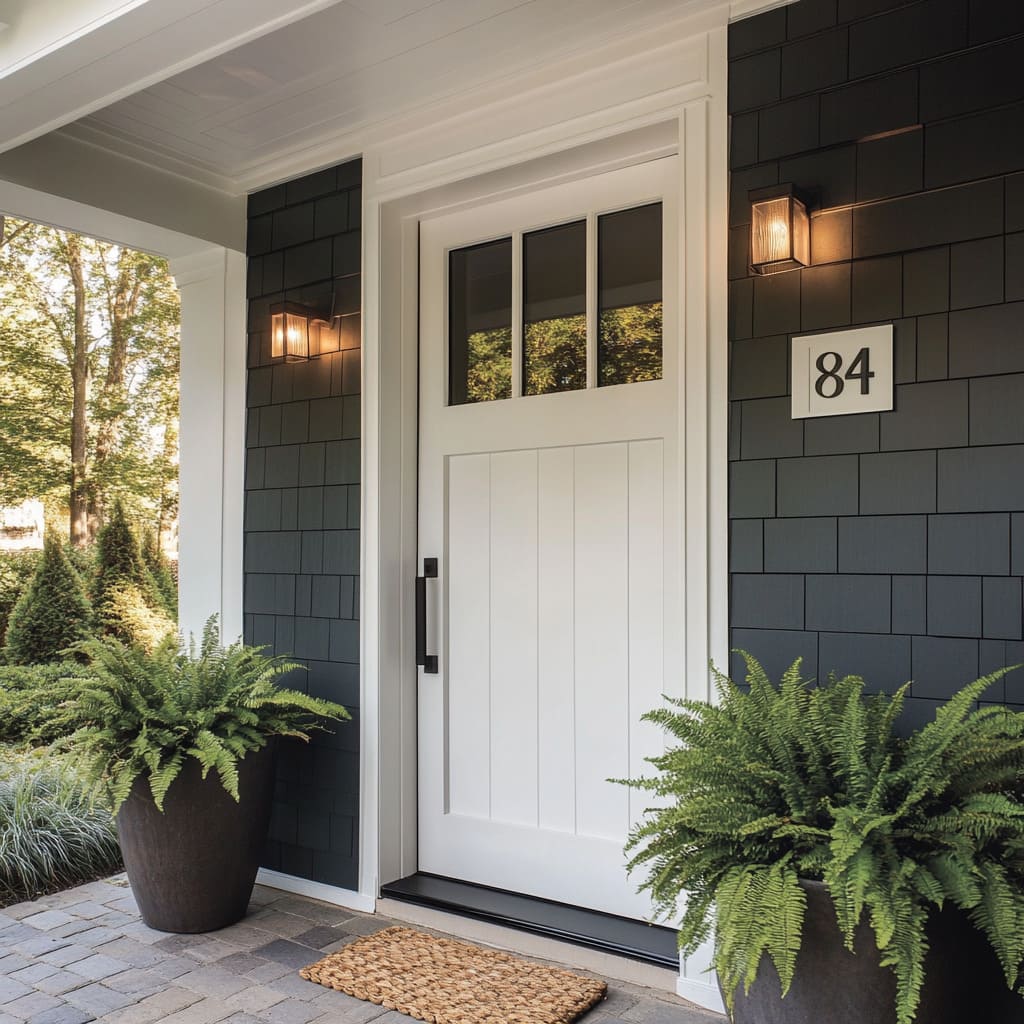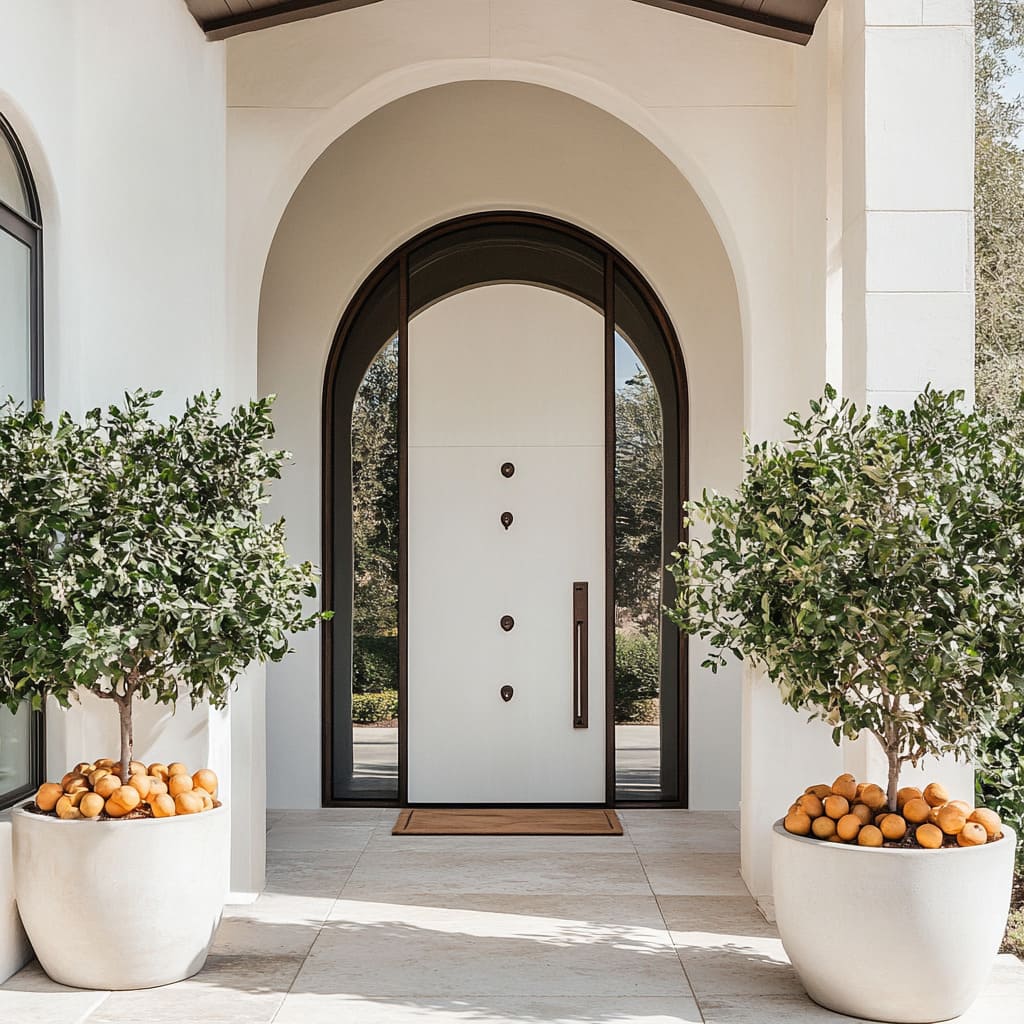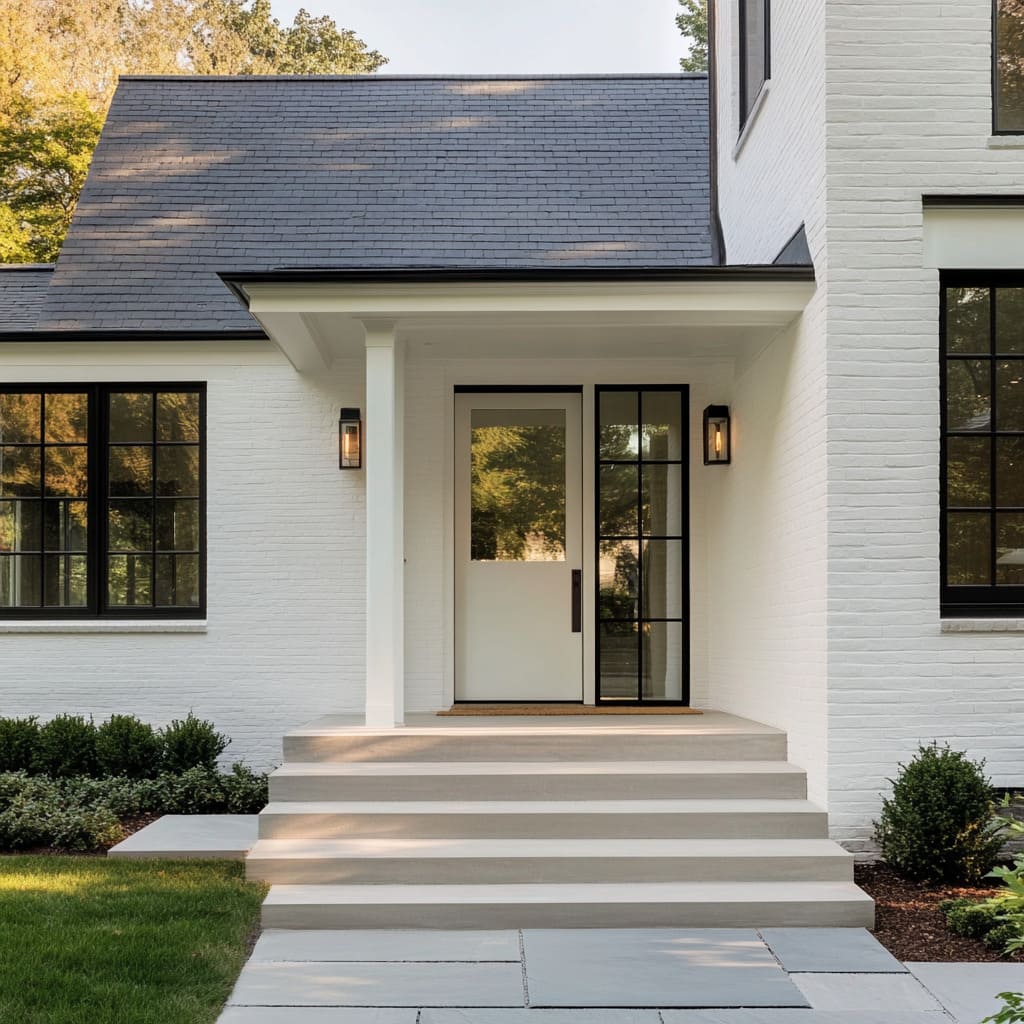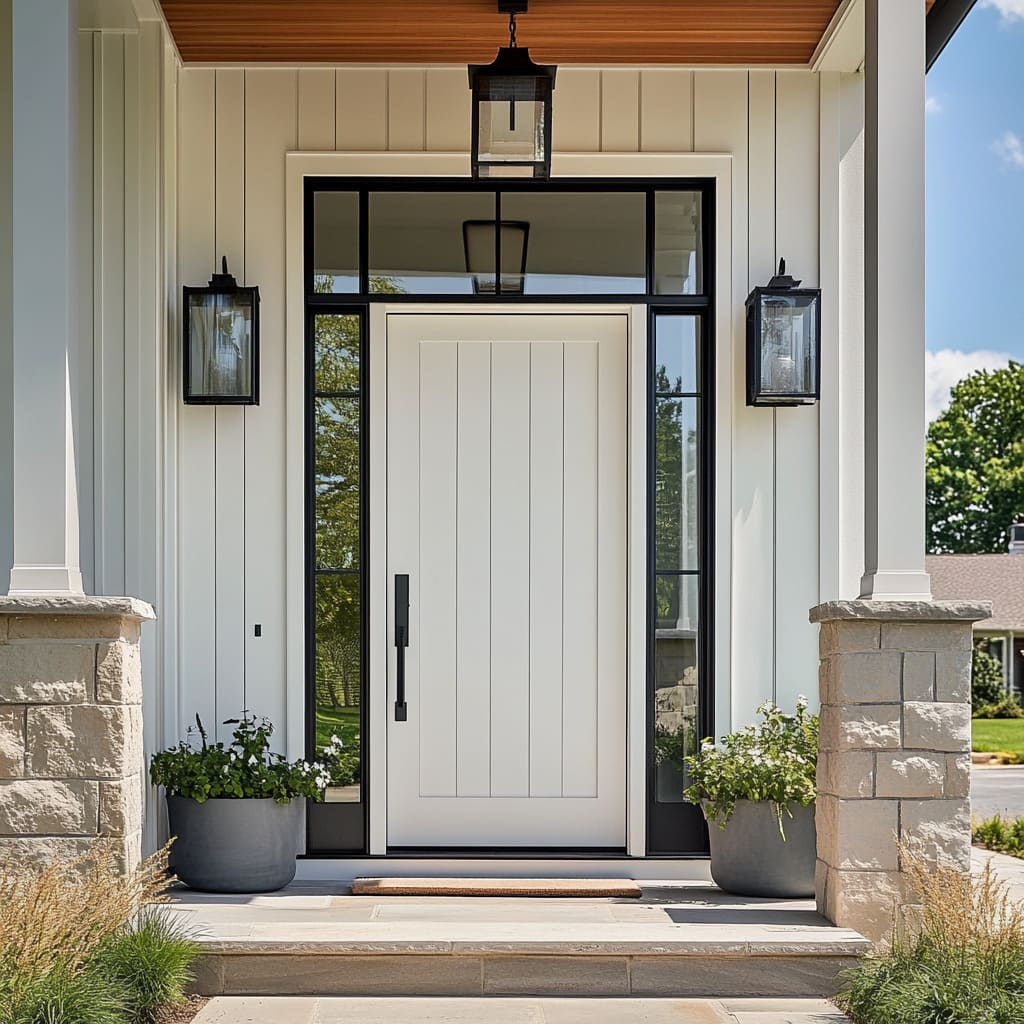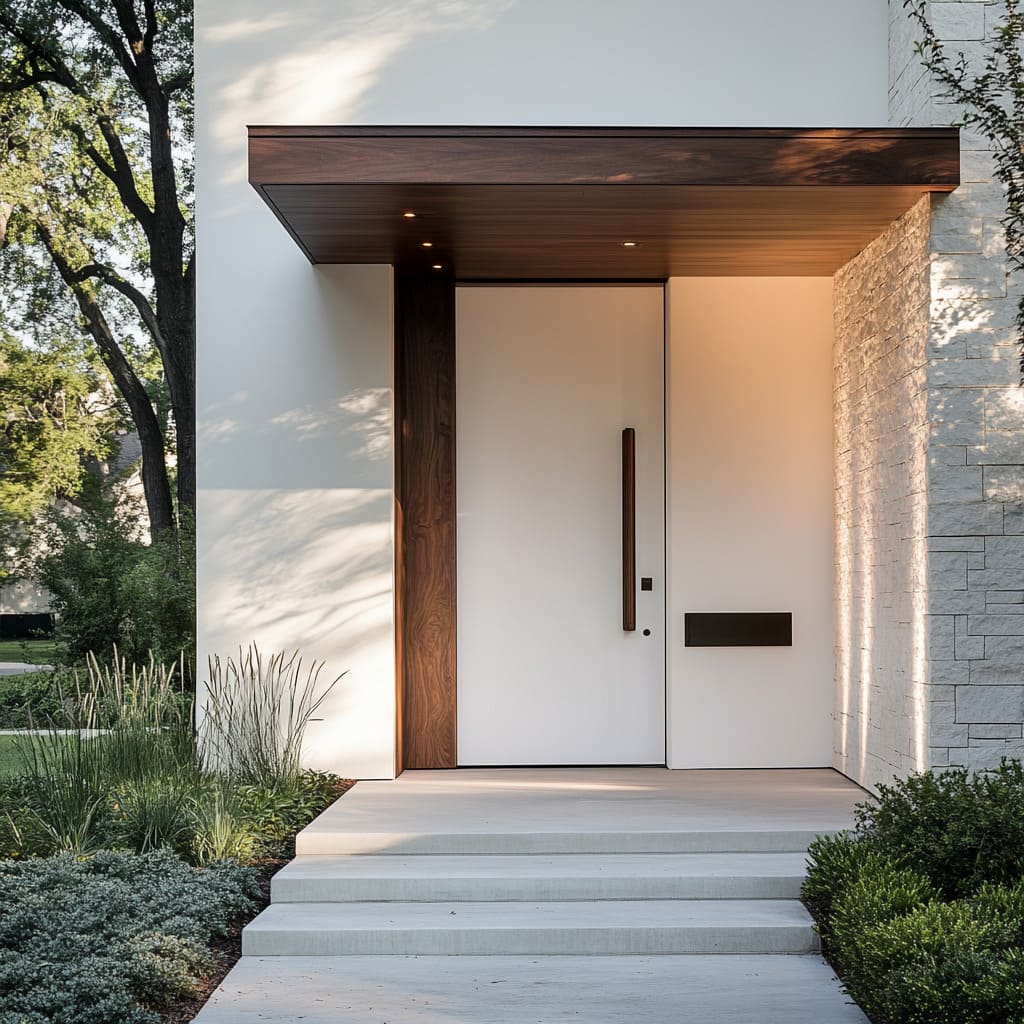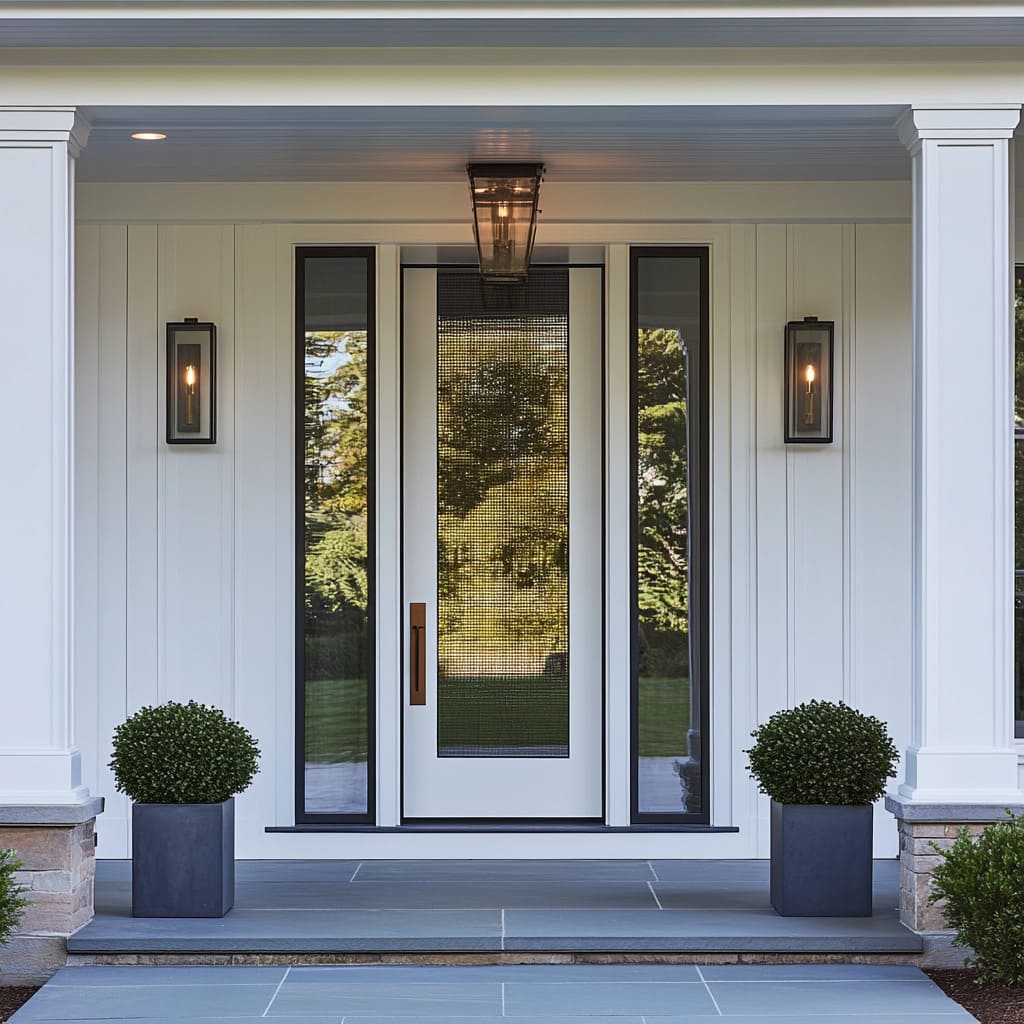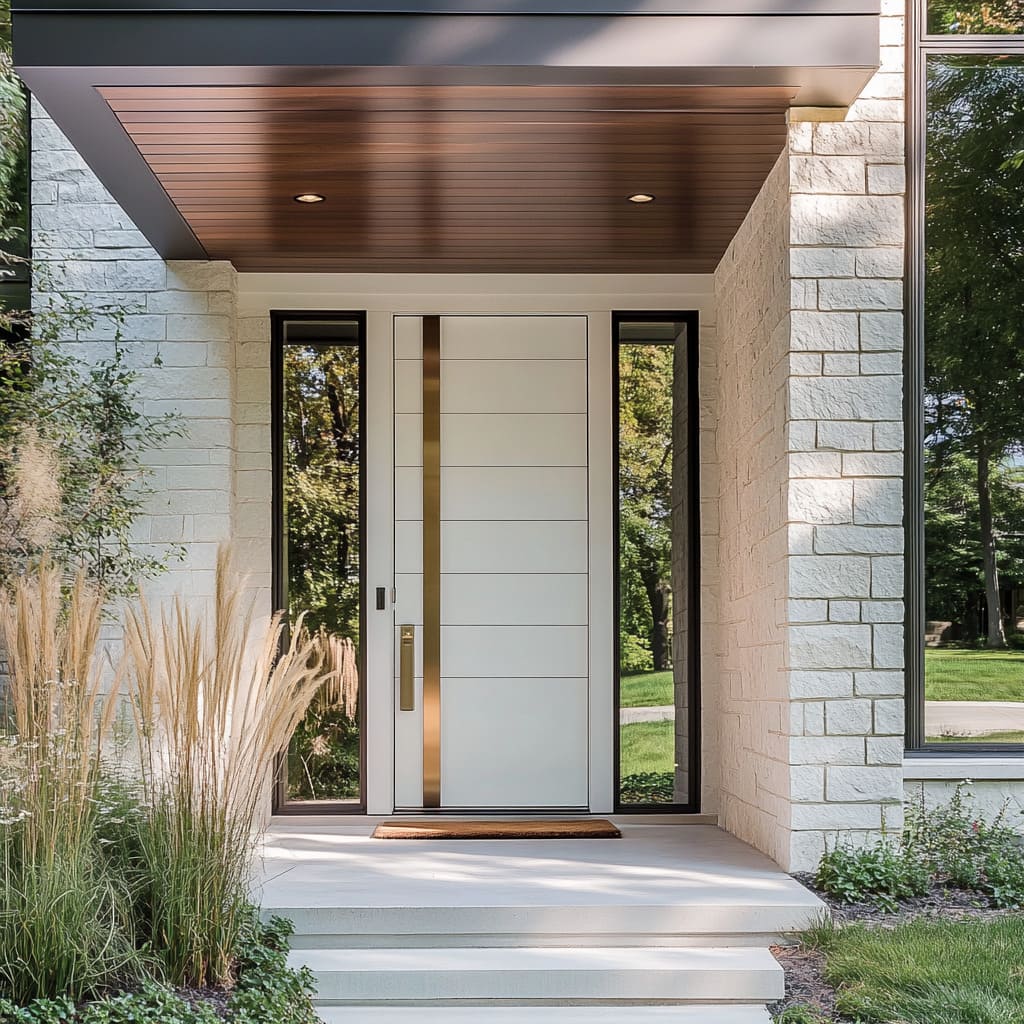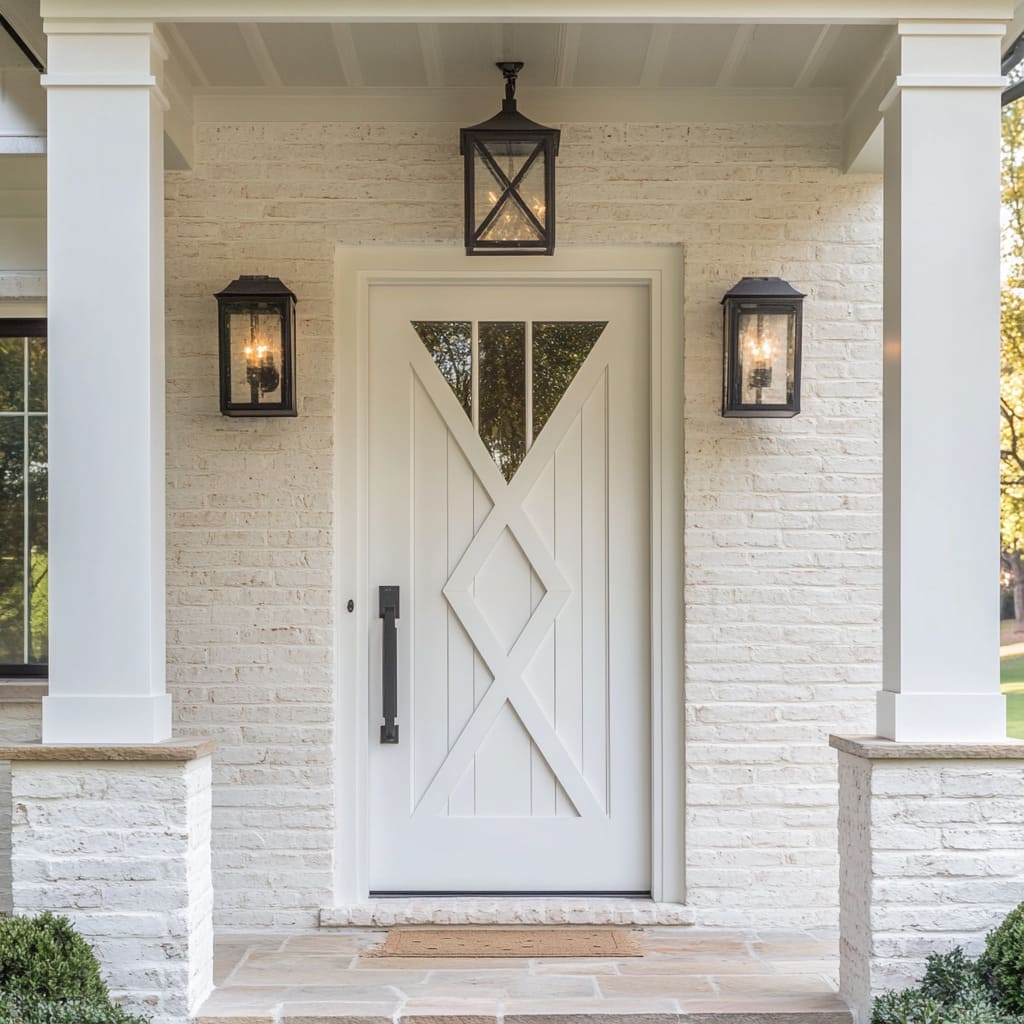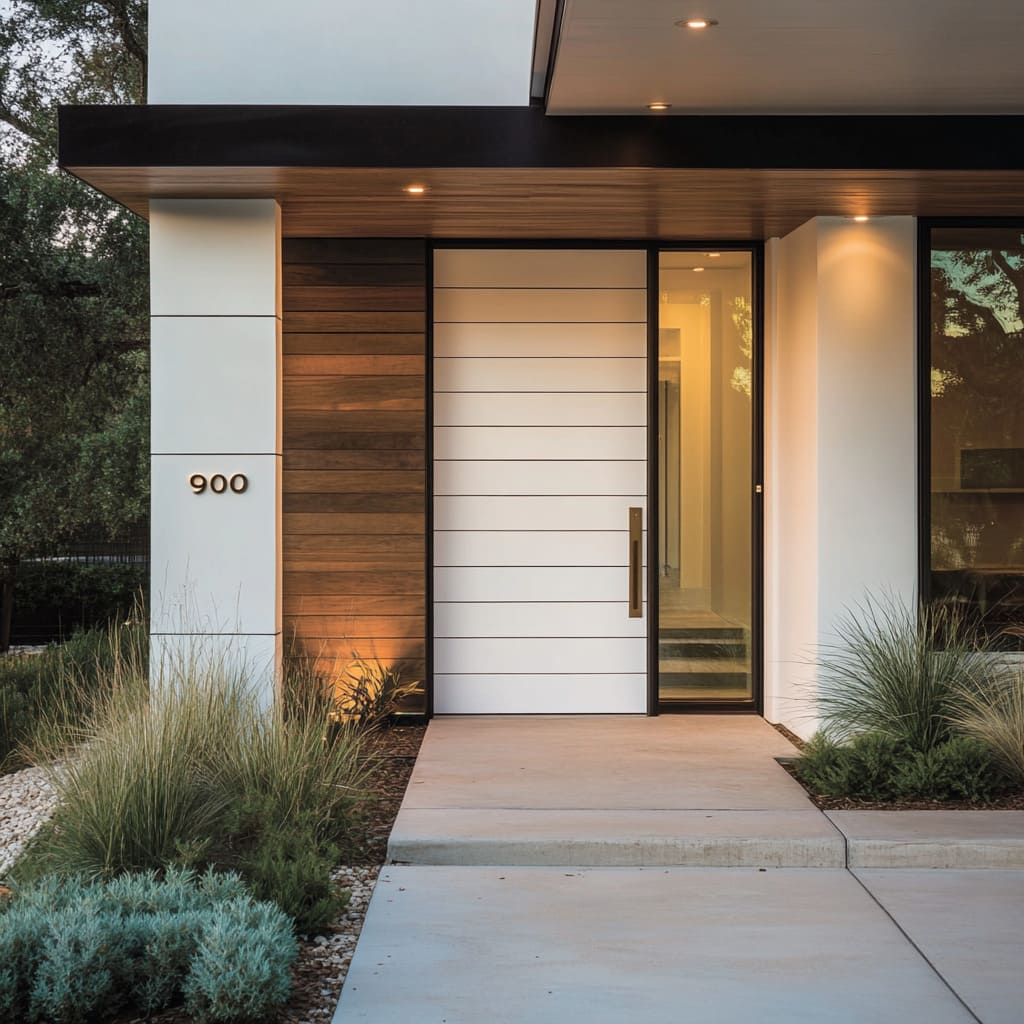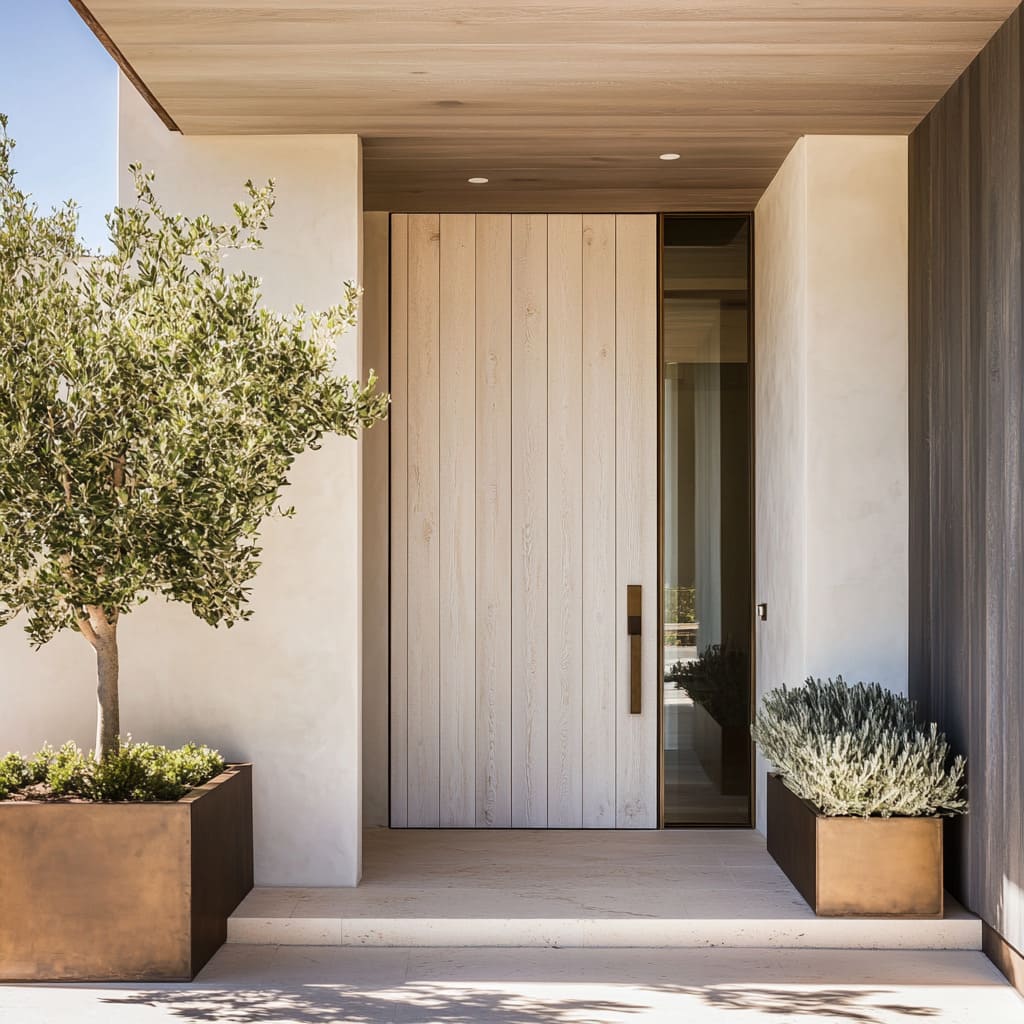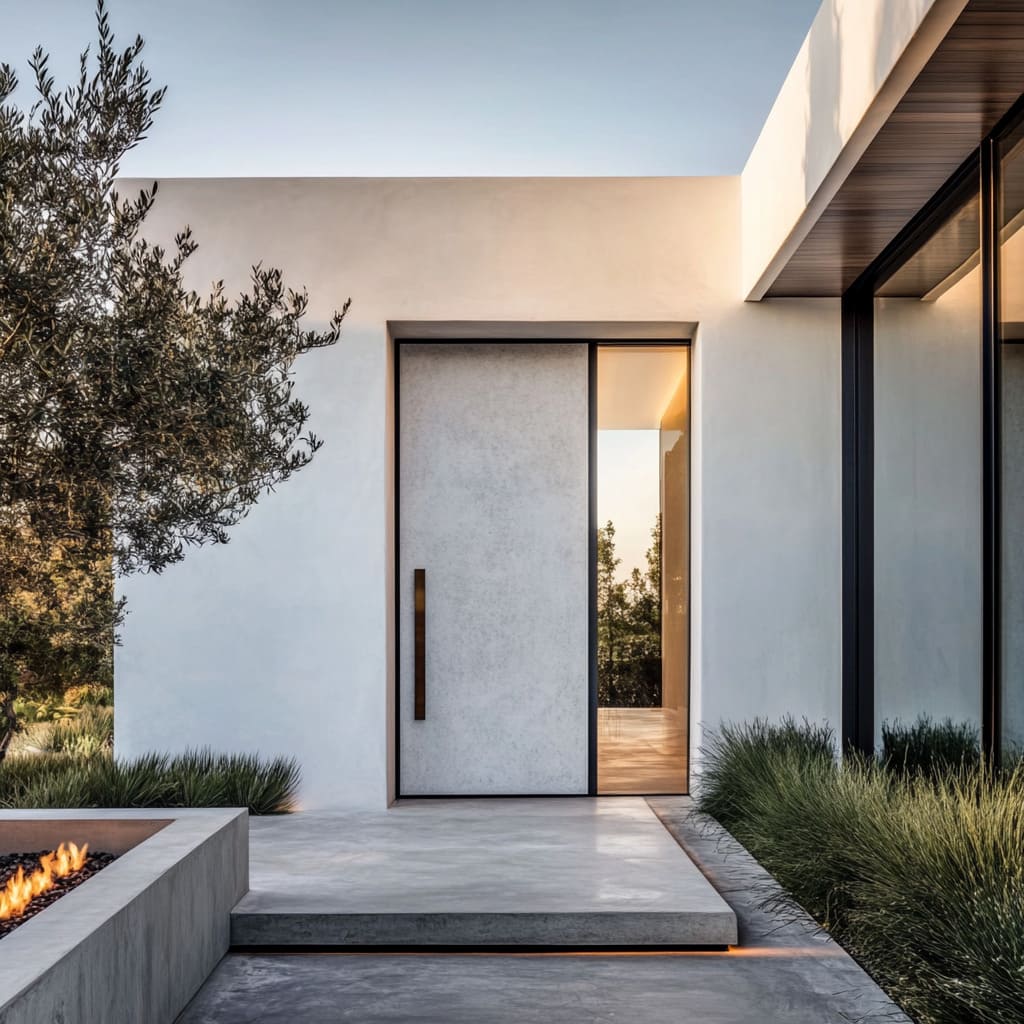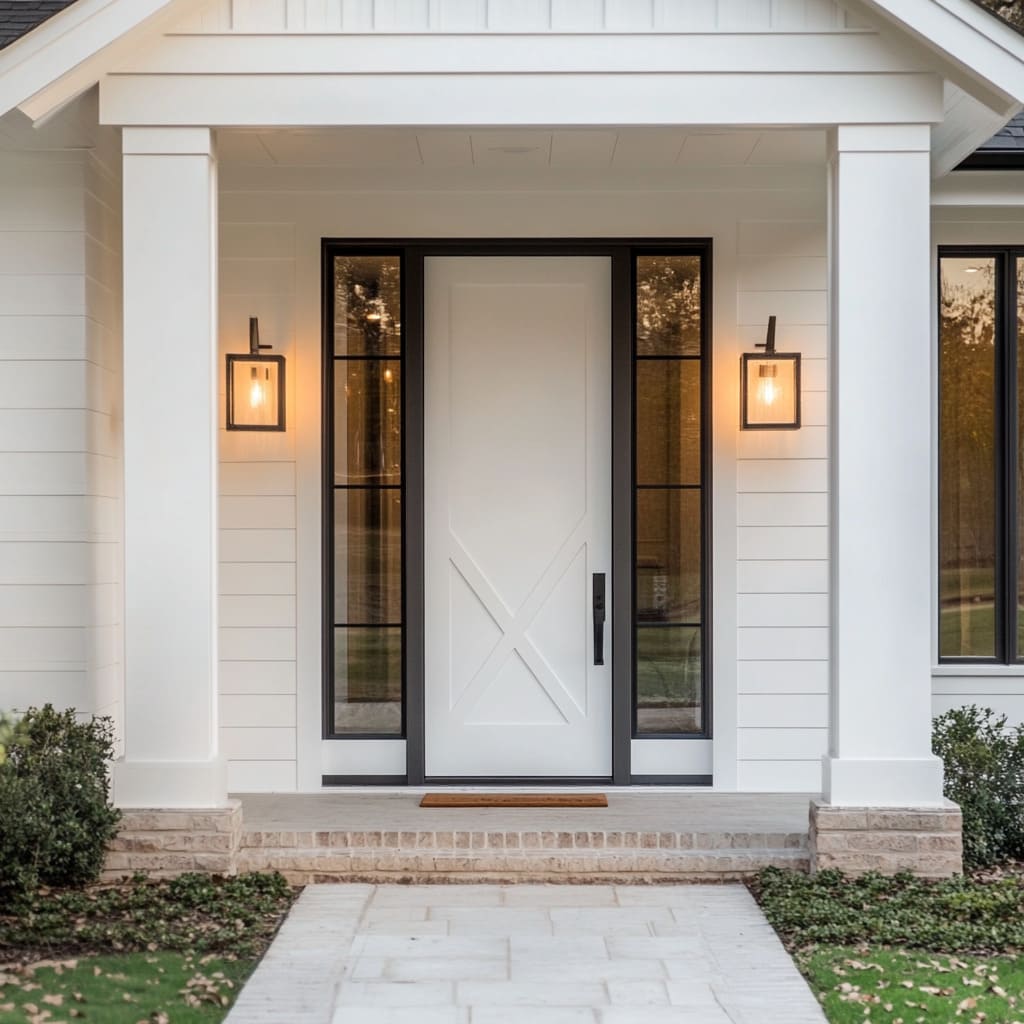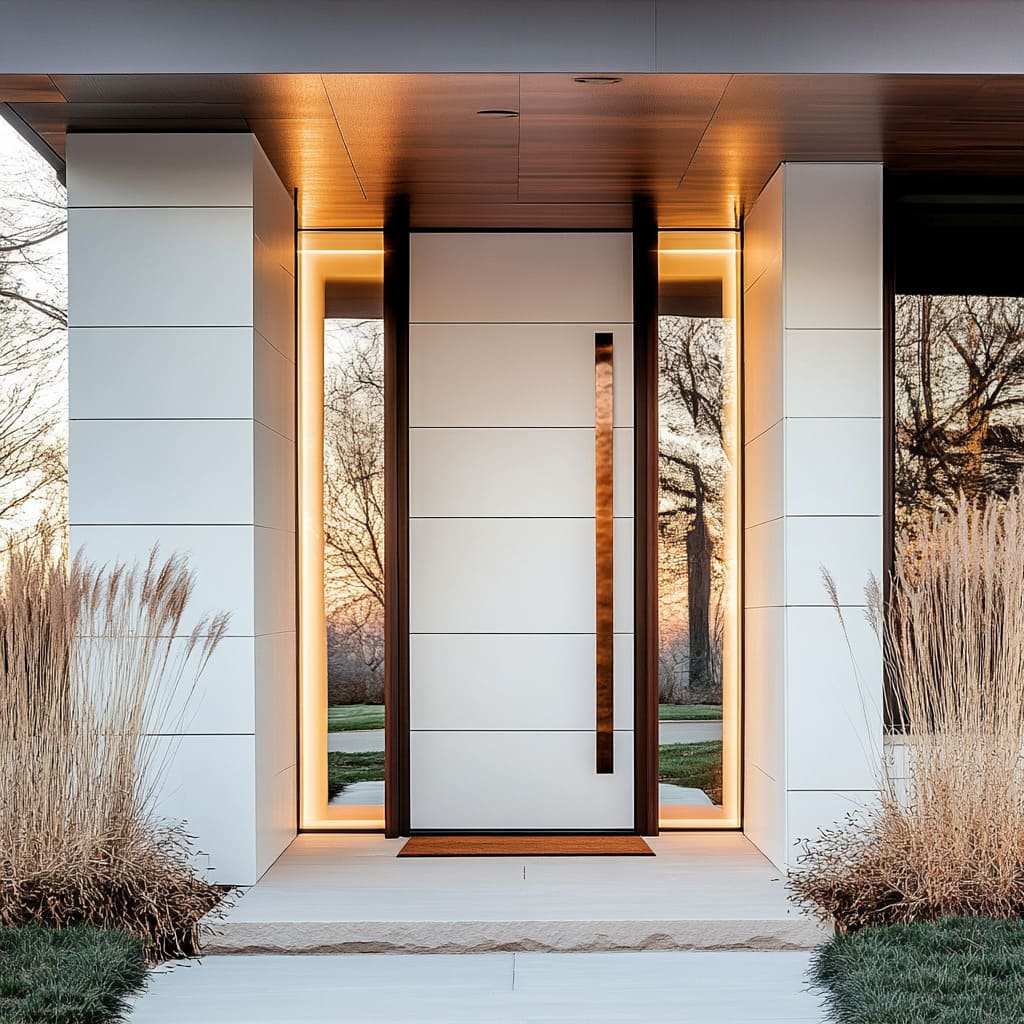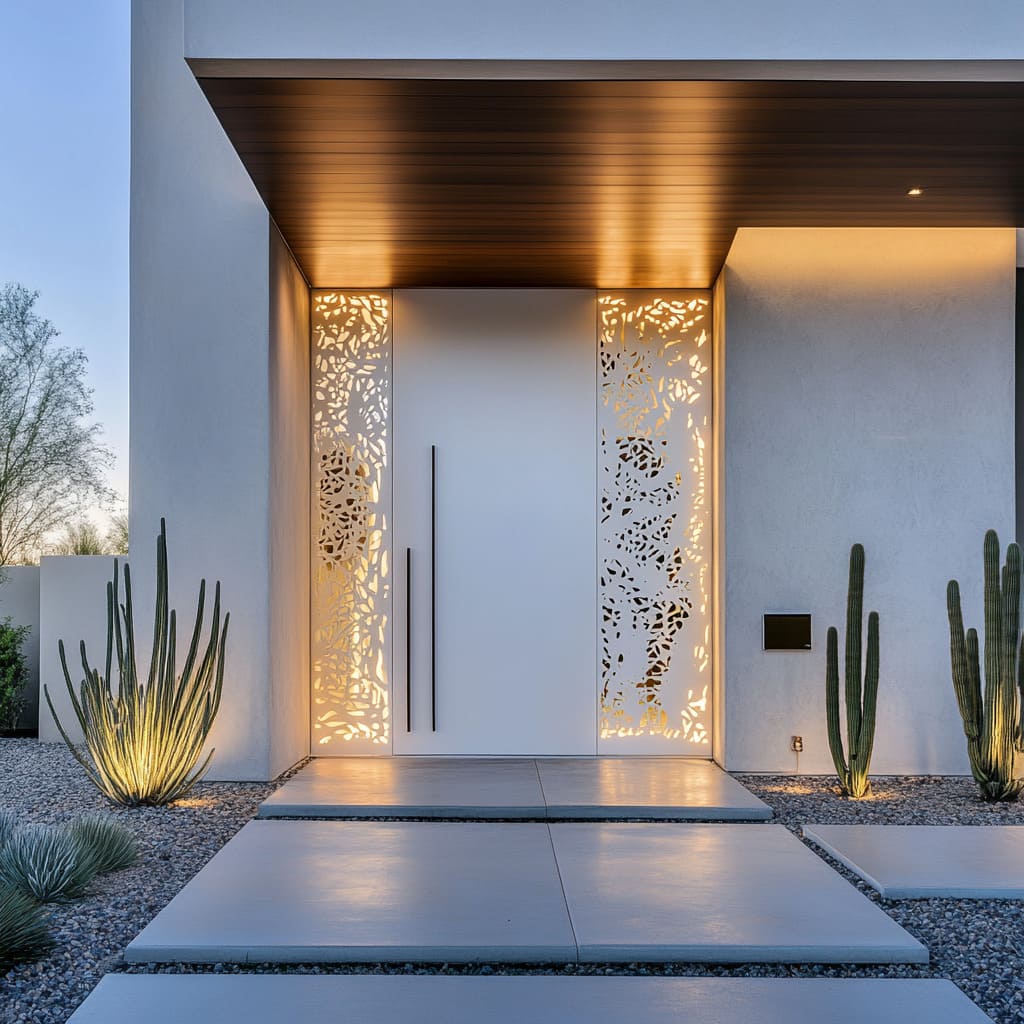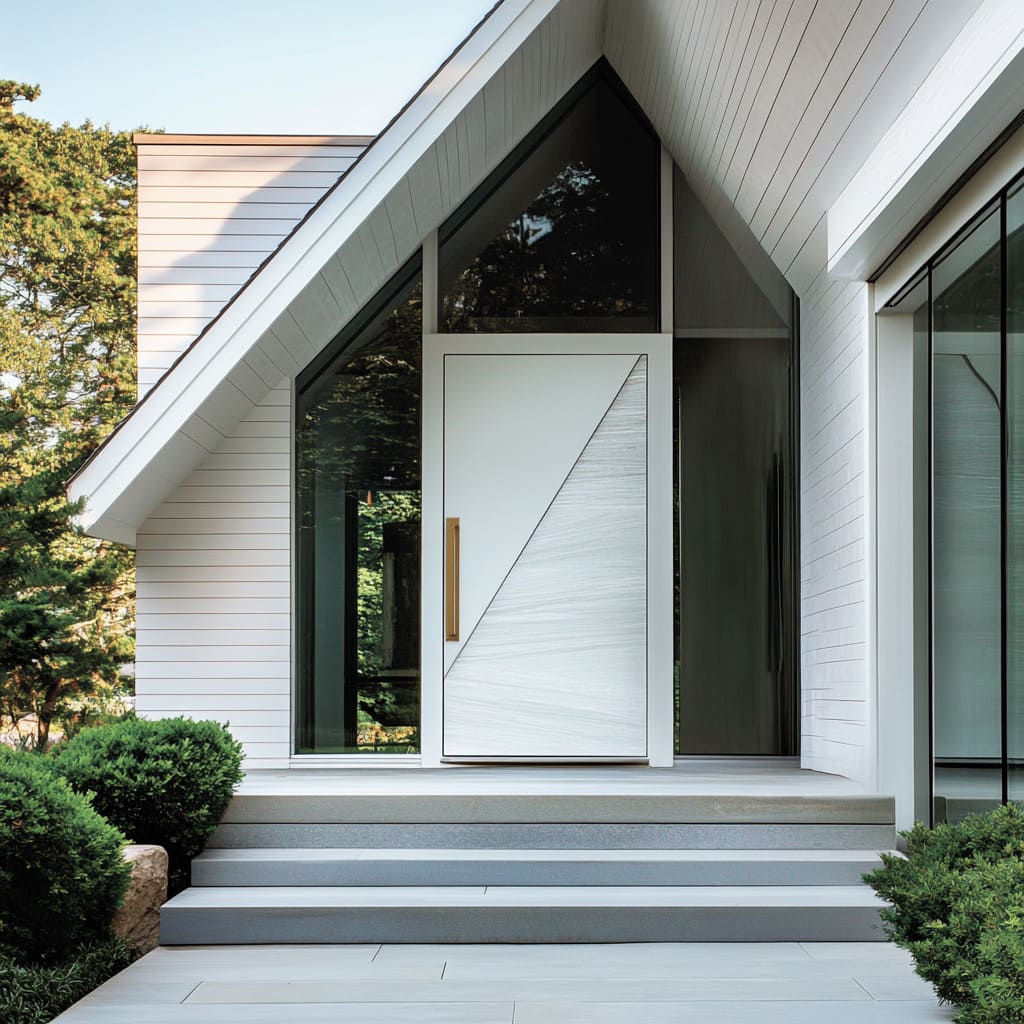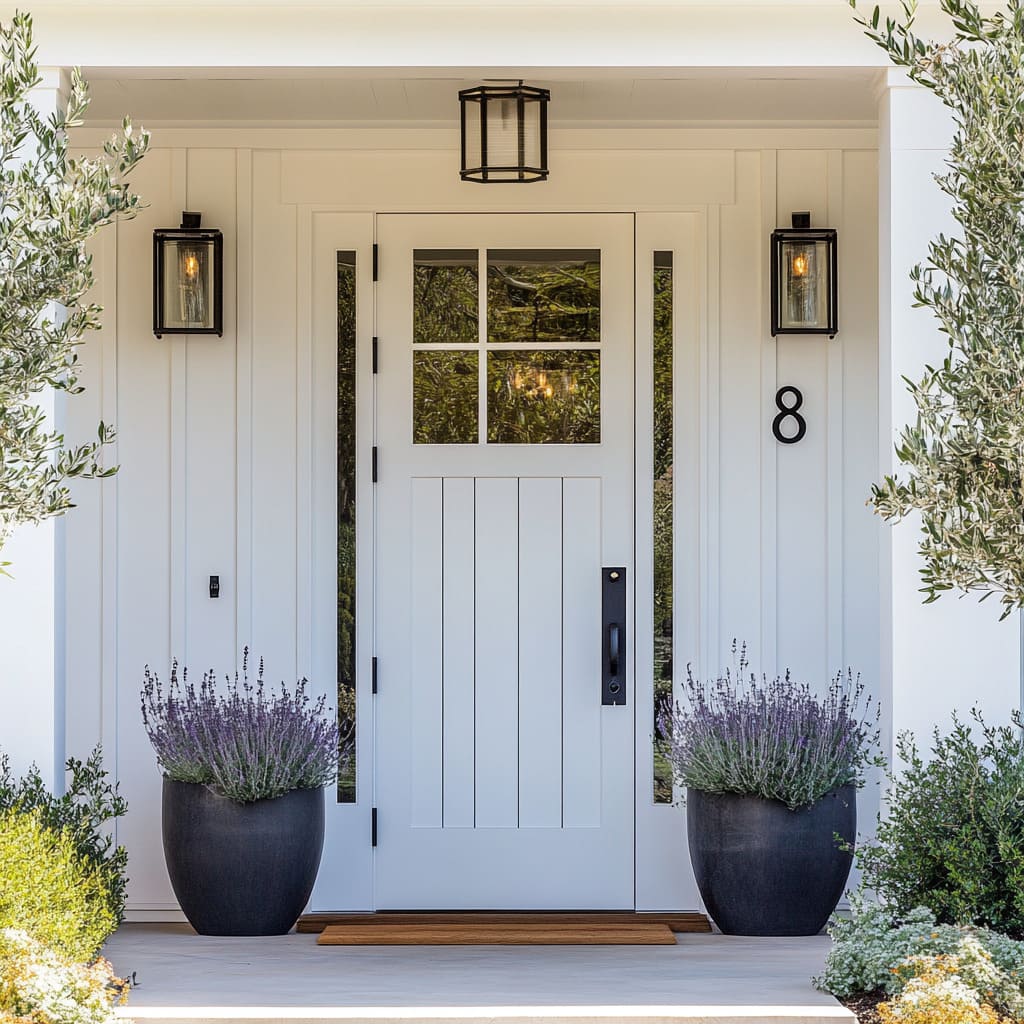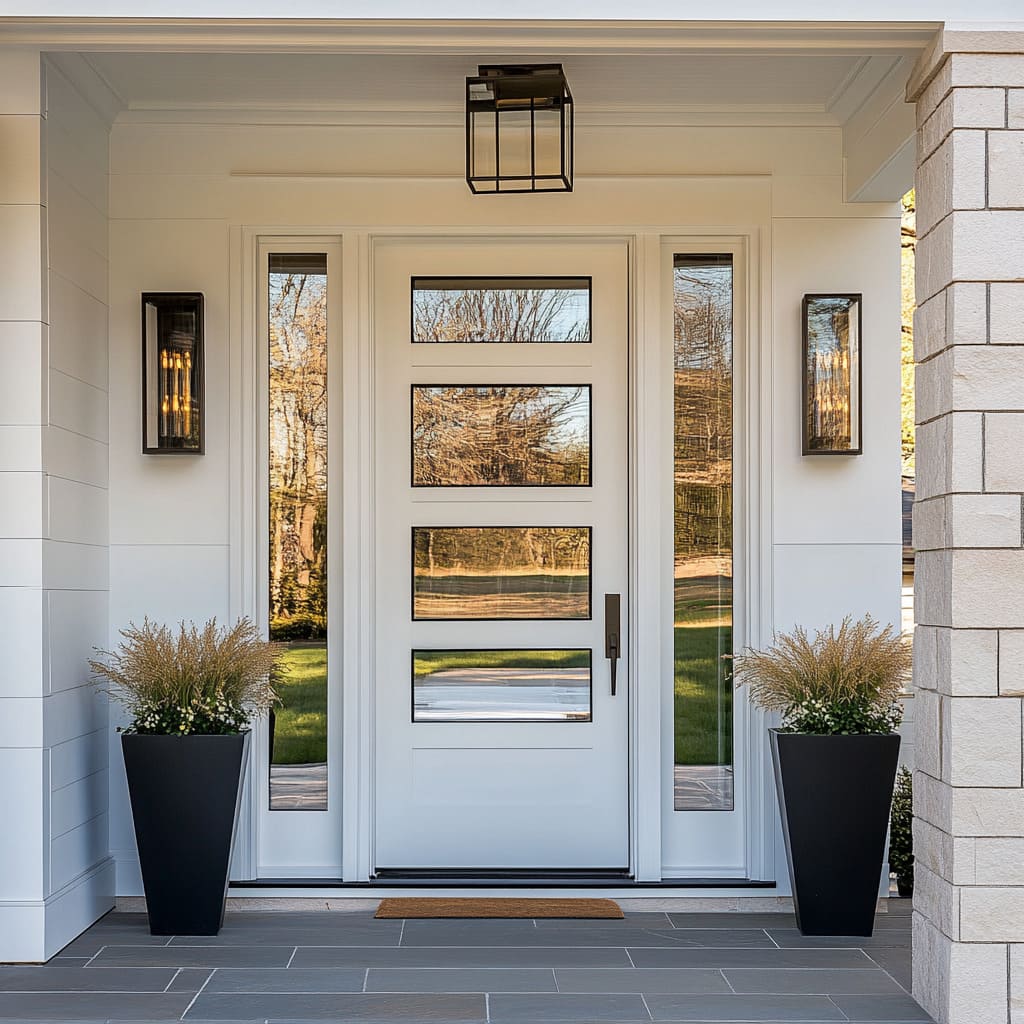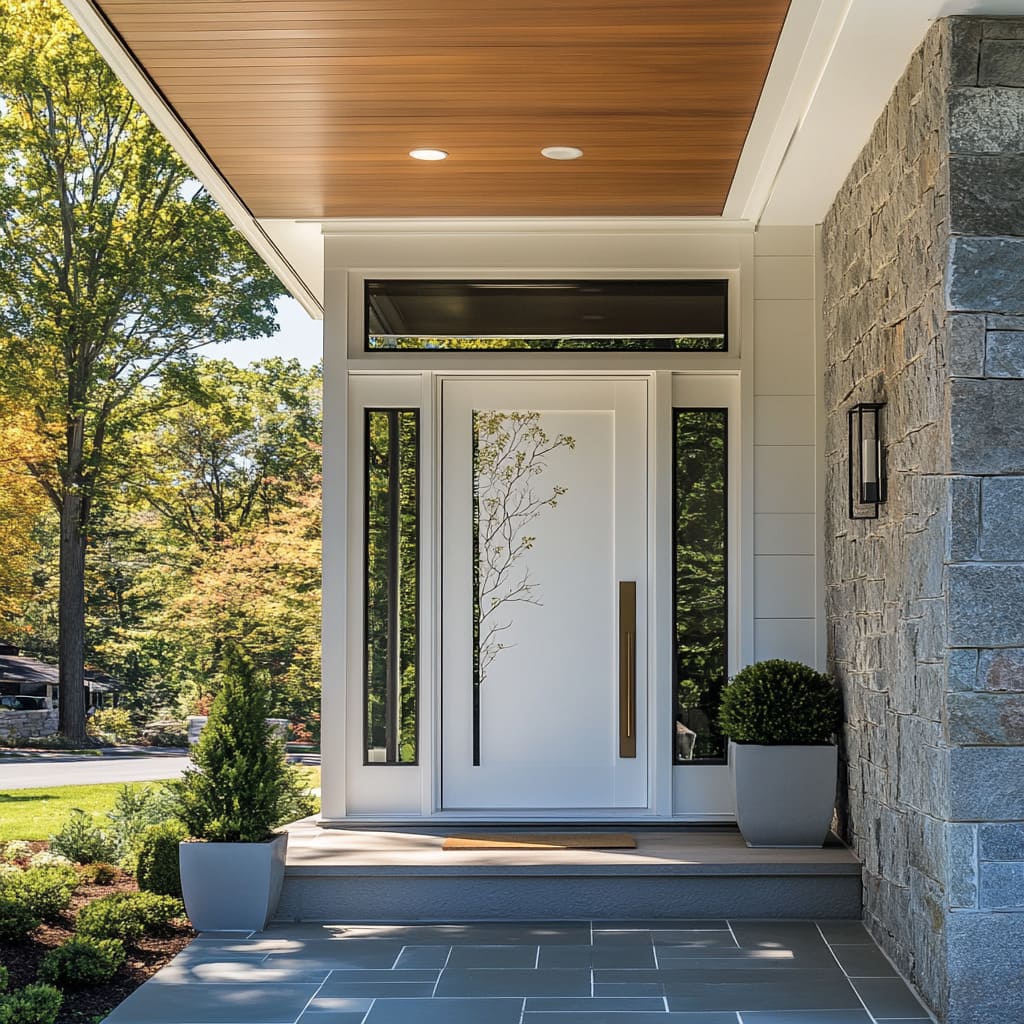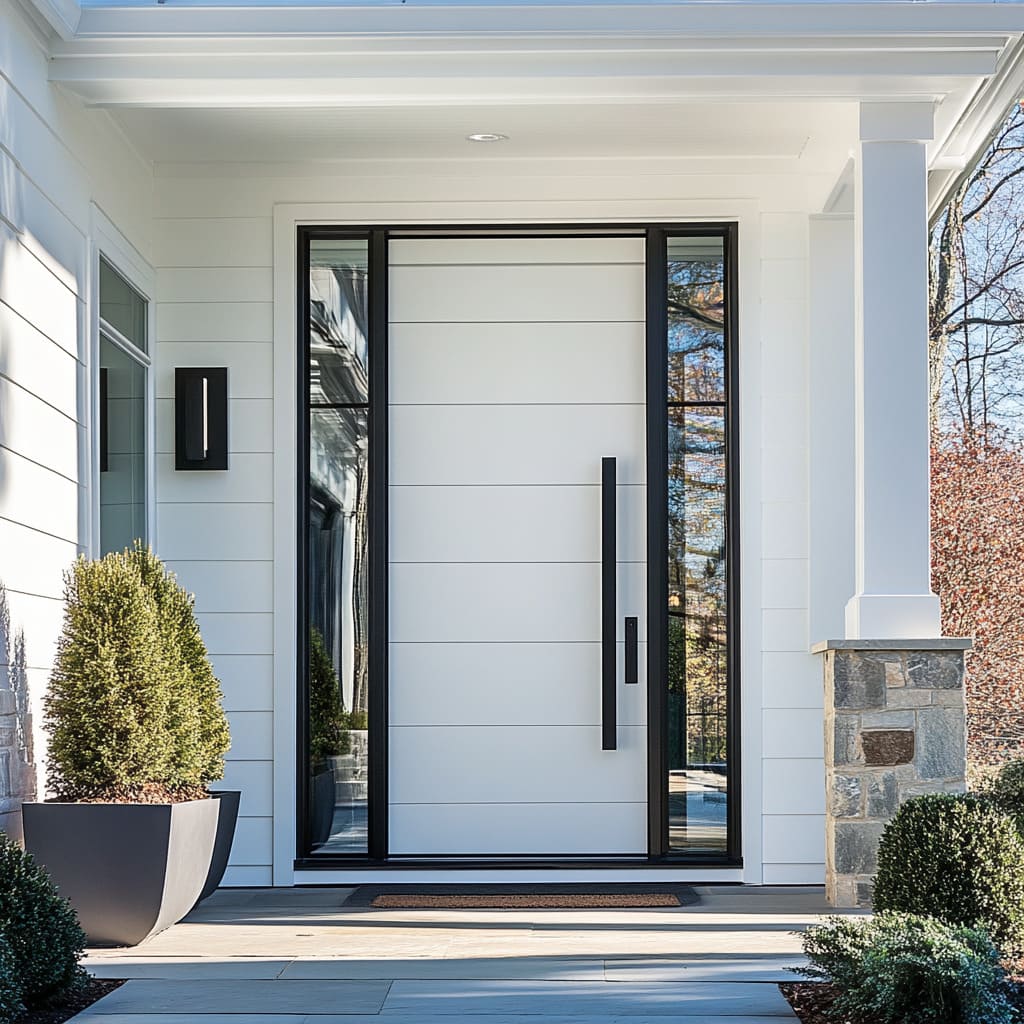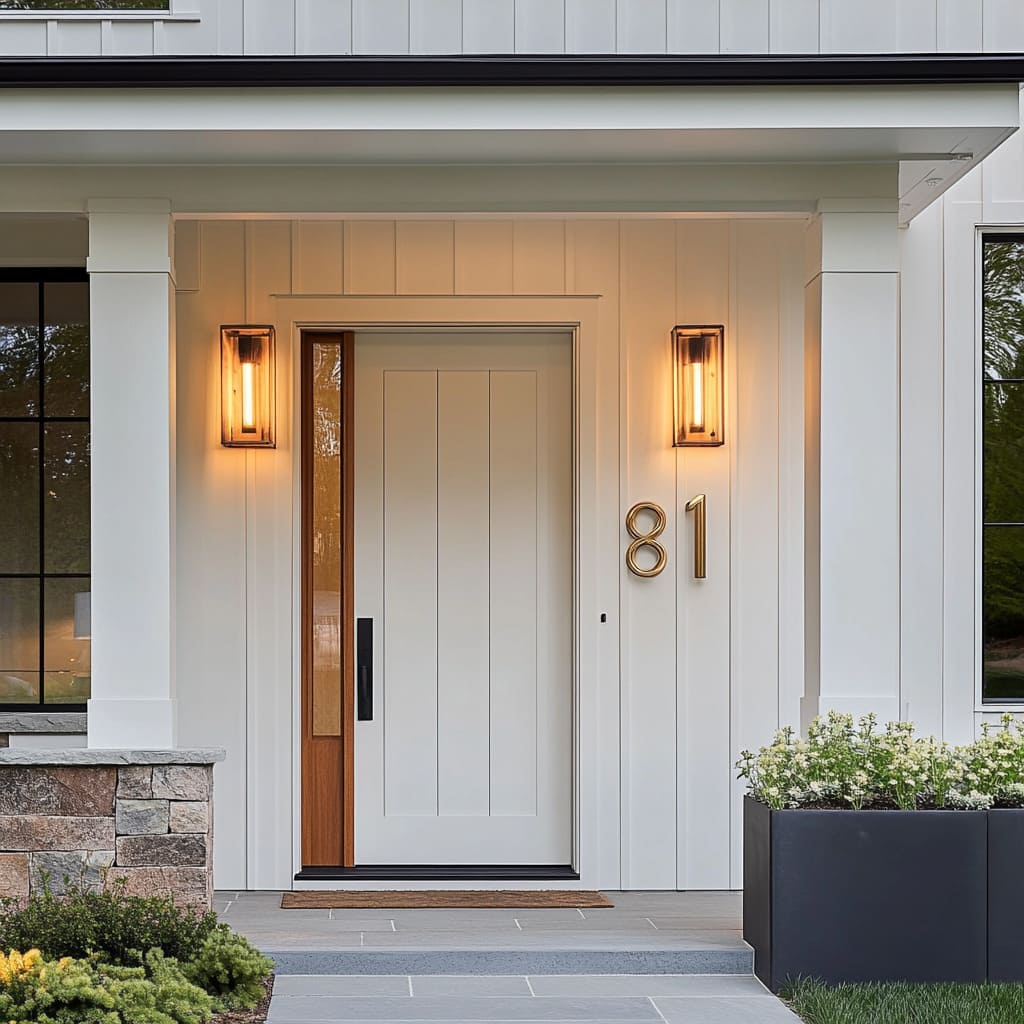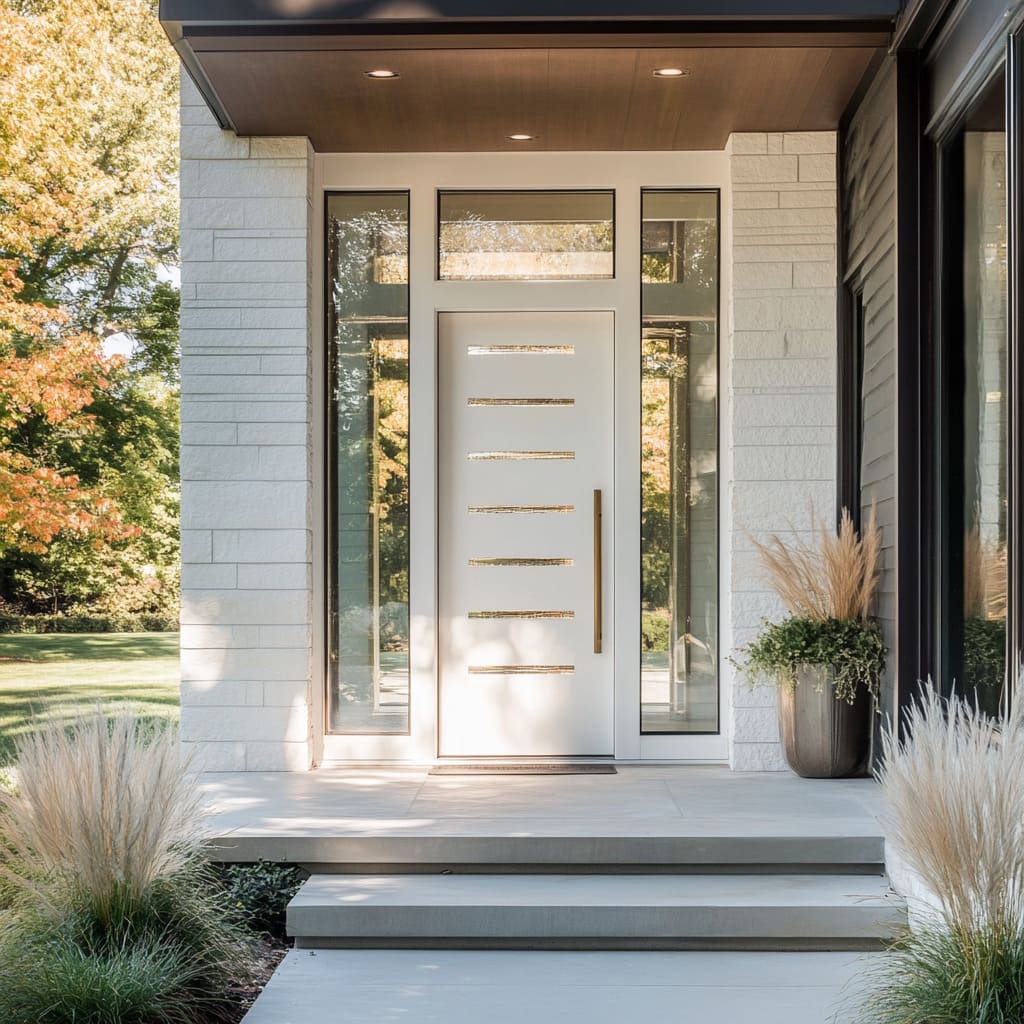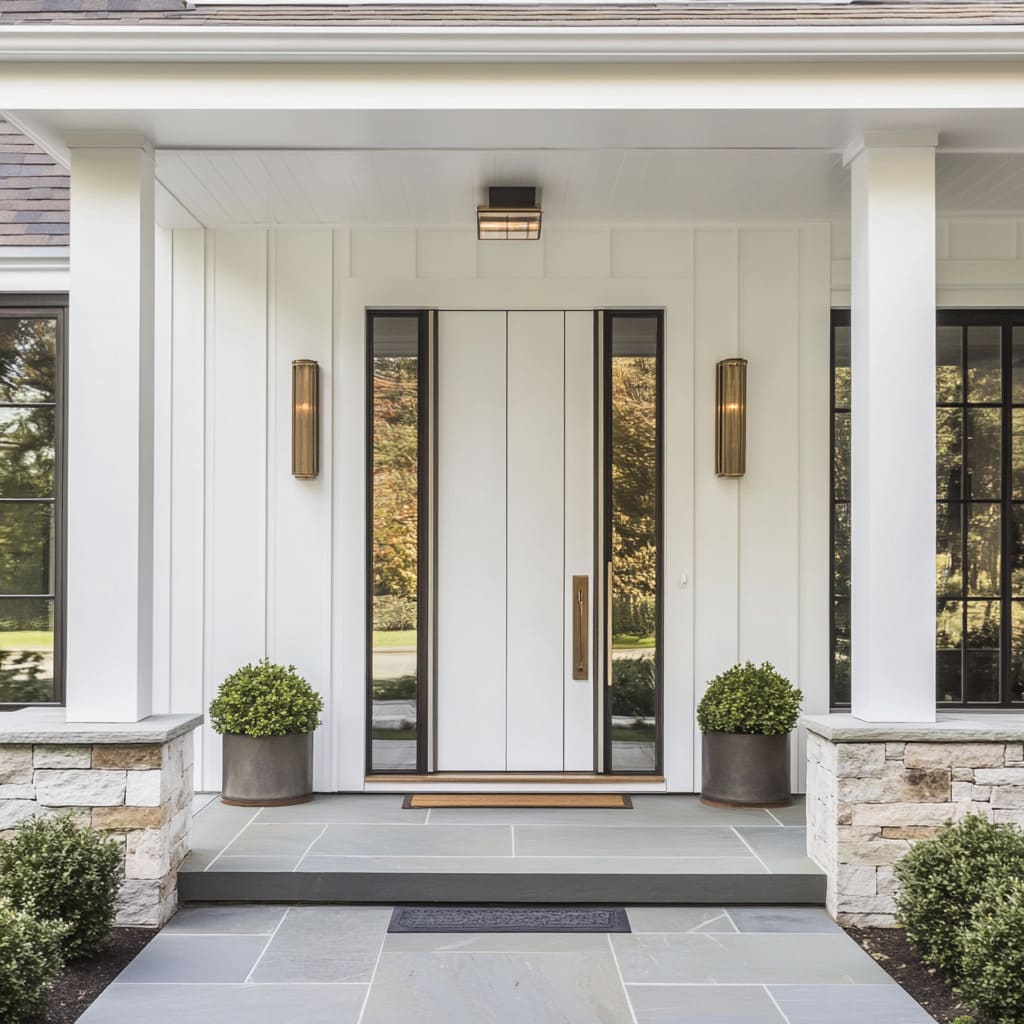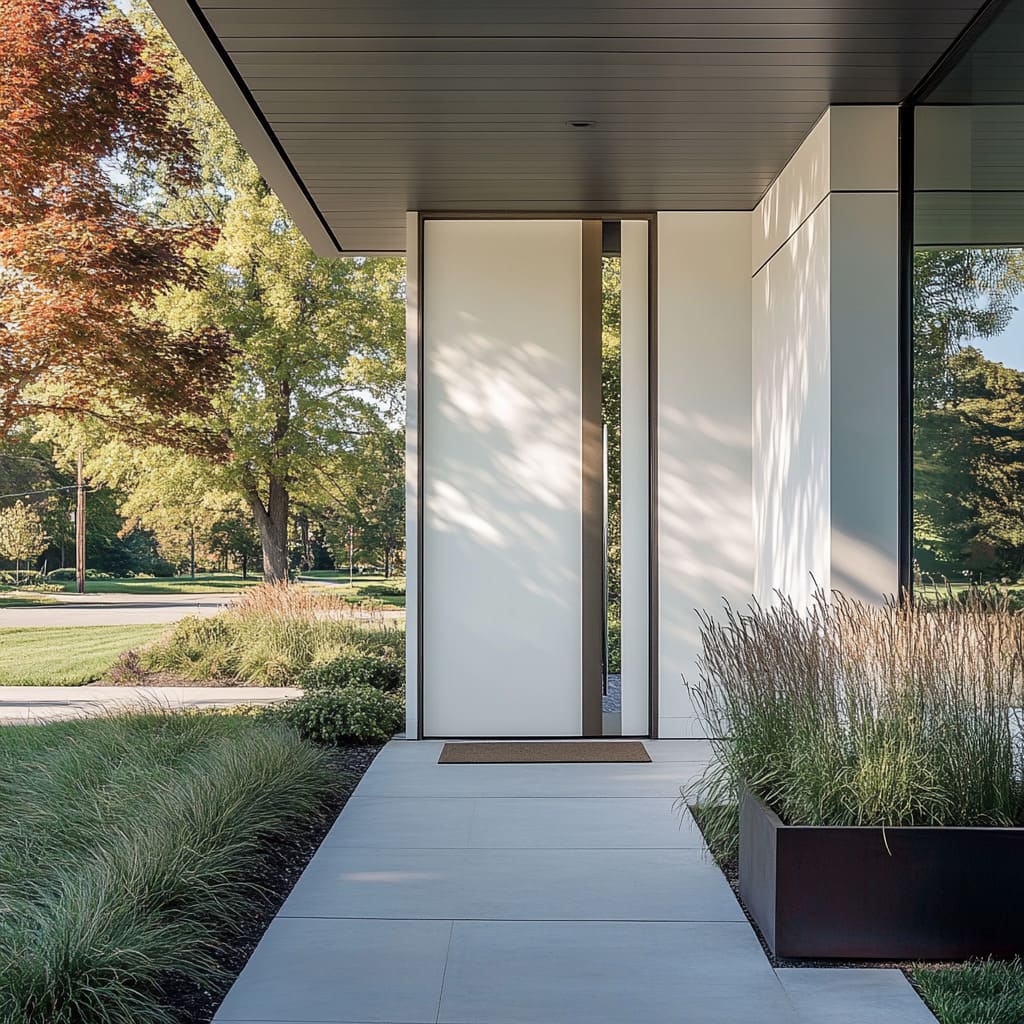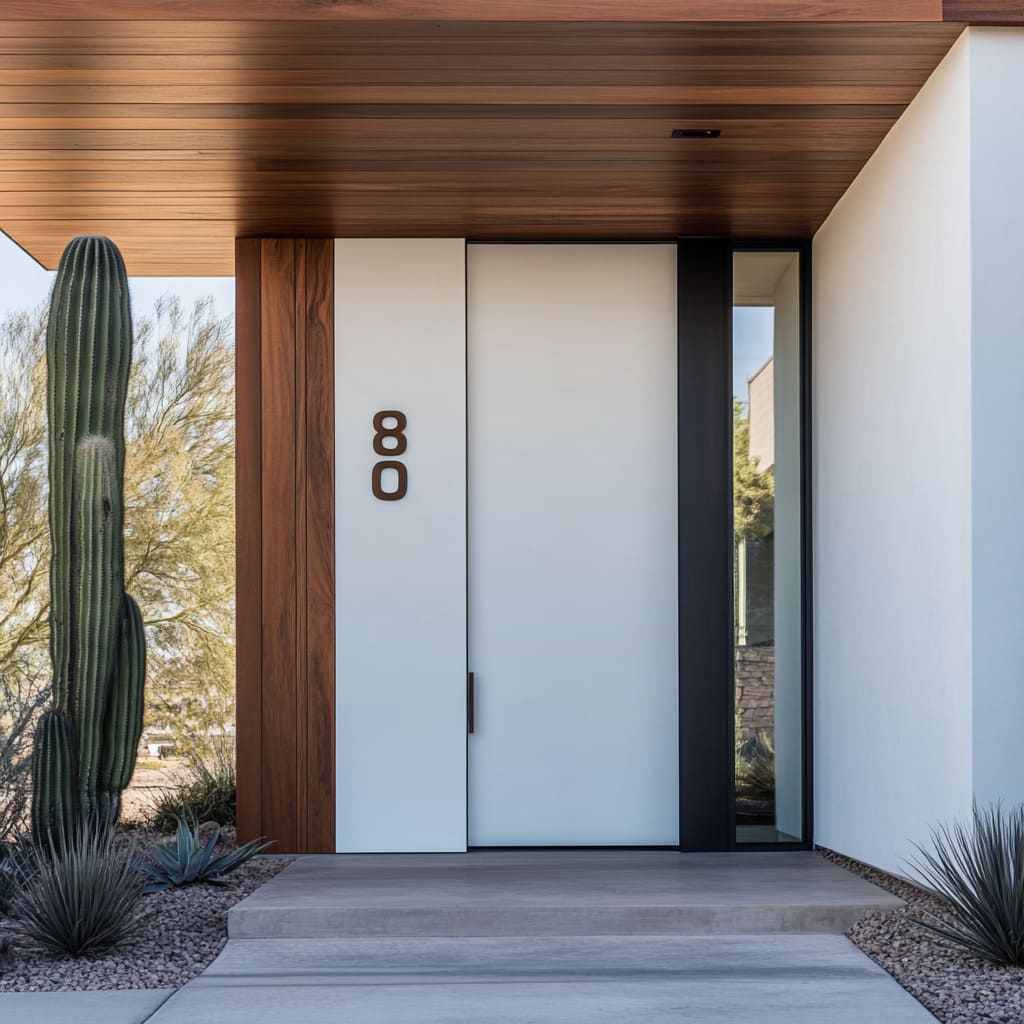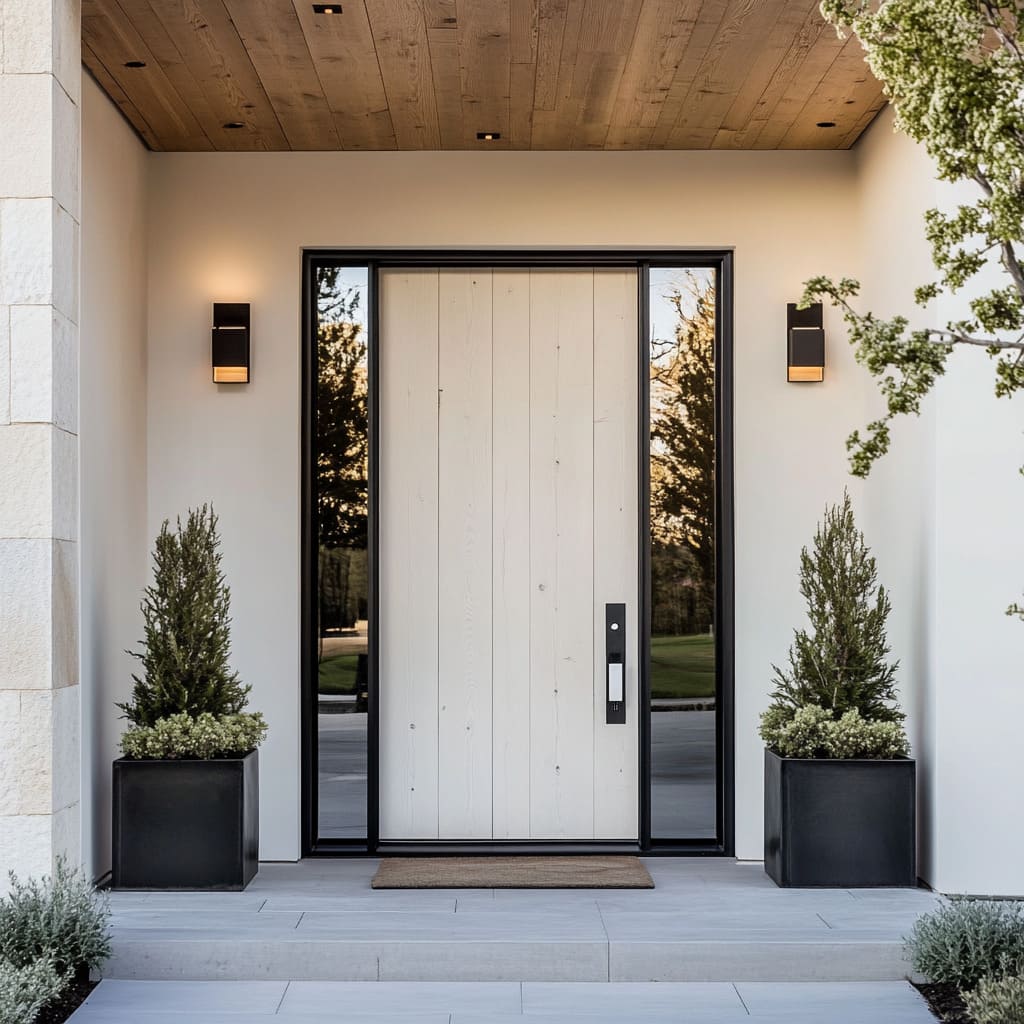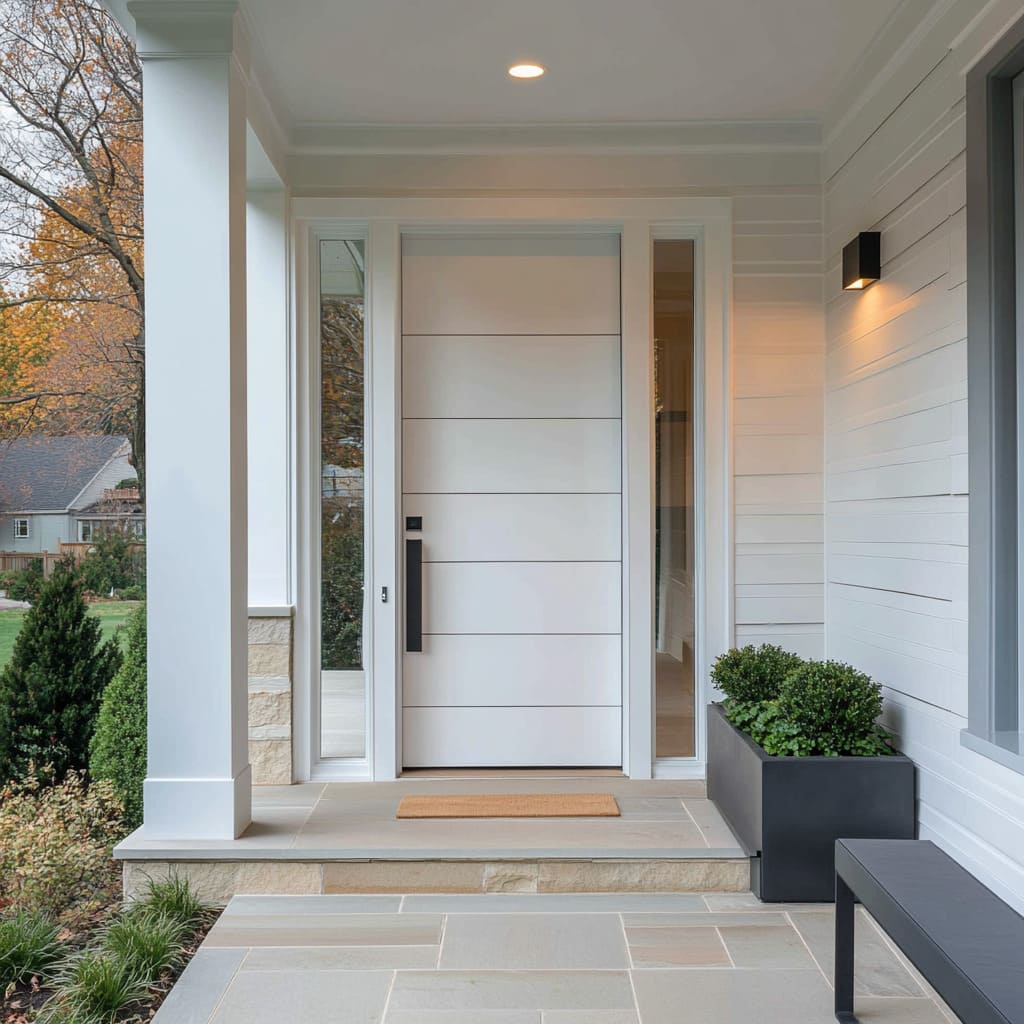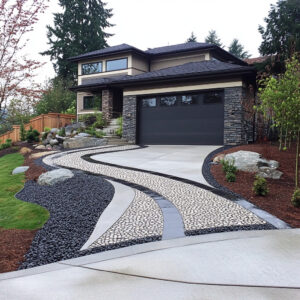A white front door might seem like a simple choice, but done right, it can add a refined and timeless touch to your home’s entrance. Whether you’re drawn to a clean minimal look, or you prefer details that give a subtle nod to traditional charm, white doors work across a range of styles—farmhouse, contemporary, modern coastal, and beyond.
They reflect light beautifully, bring a sense of brightness to the entry, and set a welcoming tone that never feels overdone.
Designers often lean on white front doors for their ability to balance simplicity with texture. It’s not just about choosing a paint color—materials like white oak, fiberglass, and even powder-coated metals create depth and interest, even in an all-white finish.
In neighborhoods where transitional and modern homes are popular—think New England suburbs or coastal California—white front doors are frequently paired with natural wood, bronze accents, or custom glass to add warmth and character.
If you’re thinking about updating your entryway, white front doors offer a versatile foundation. From pivot styles with smart technology to classic farmhouse doors with hand-forged hardware, there’s a wide variety of options that feel current yet timeless.
In this guide, you’ll find ideas that show how texture, lighting, and thoughtful materials can make a white front door stand out without shouting for attention.
The Dialectic Between Crisp White and Natural Wood Tones
- Many entries showcase subtle wood details (white oak, walnut, mesquite, teak) set against a painted or lacquered white surface. The tension between white’s cool neutrality and the organic warmth of natural wood helps define a home’s character.
- Designers often leave grain visible beneath a paint or lacquer finish. This creates a layering effect: up close, the viewer recognizes natural texture; from a distance, the door appears as a clean, monochromatic plane. This duality is a careful balance between modern simplicity and handcrafted nuance.
- The wood strip or panel typically provides visual anchoring and can carry elements like handles or house numbers. This placement—often off-center—prevents the door from feeling too uniform and adds depth even when the rest of the surface is minimalistic.
Practical & Subtle Impact:
- A narrow band of wood can highlight the vertical or horizontal axis of the door, subtly directing the eye.
- Visible grain or reclaimed textures add a layer of comfort to what might otherwise be a sterile surface, making the entry more approachable without being overtly decorative.
Metal Inlays, Strips, and Accents: Material Aging and Contrast
- Bronze, brass, and stainless steel inlays are frequently used to introduce lines of warmth or cool reflectivity against white. Over time, certain metals (bronze, brass) develop patina, causing the door’s appearance to shift gradually.
- When designers leave metal unsealed (particularly bronze), the evolving surface becomes part of the design narrative. This demonstrates a sense of “living finish,” in which the door’s look changes subtly with exposure to the environment.
- Slender metal accents or broad bands can bring a sense of precision. Though minimal in area, the shimmer or patina underscores the door’s geometry and can complement or contrast the home’s broader façade.
Useful Tips:
- Fluctuations in color from patina create a dynamic interplay of materials over years.
- On doors where white paint is extremely matte, the slight reflectivity of metal stands out even more, as any glint or patina gets amplified.
Creative House Number Integration
- House numbers become part of the overall composition rather than an afterthought. They are carved into insets, floating on standoffs, backlit, or even cut through the wood to let interior light glow outward.
- Using metal or resin for the numbers can reinforce or contrast the main inlay material. For instance, brushed brass set into walnut yields a luminous focal point.
- In several examples, the numbers are deliberately large or arranged vertically, transforming what is typically a functional feature into a design statement.
Helpful Ideas:
- A house number that merges with the door or side panel can clarify the property’s identity in a way that feels artful rather than purely utilitarian.
- The arrangement of numbers (diagonal, vertical, flush inset) may echo other lines or shapes on the façade, tying together architecture and signage into one cohesive move.
The Pivot Door Mechanism and Its Aesthetic Effects
- Many of the more contemporary doors employ a pivot system rather than side hinges. This choice removes visible hardware and can create the illusion that the door “floats” within its frame.
- Pivoting adds an element of spatial drama: it changes the user’s experience of opening the door, often allowing for a larger slab without the typical sagging issues of hinged doors.
- This mechanism can imply generosity in the entry, but also demands greater precision in engineering and heavier-duty hardware hidden within the floor or threshold.
Smart Pointers:
- More seamless door edges: Freed from typical hinge hardware, the edges can carry inlay details or remain completely clean.
- Pivot doors can require careful weatherproofing, especially in regions with significant temperature shifts or rainfall. This underscores the behind-the-scenes technical mastery needed to make these designs not just beautiful but functional.
Varying Approaches to Glass Integration
- Glass appears in many different forms: frosted, smoked, acid-etched, laminated with mesh, or micro-perforated patterns. Each variant can affect privacy, natural light, and texture.
- Designers frequently choose to place the glass off-center or in multiple smaller panels, creating a balanced asymmetry. This can guide sight lines and subtly break up the door’s surface.
- Some doors incorporate layered glazing with etched patterns or partial transparency zones, letting in diffused daylight without compromising privacy. Others use linear or geometric motifs in the glass to reflect the home’s overarching design language.
Hands-On Tips:
- Shifting daylight across etched or textured glass can produce interesting light-and-shadow effects inside the foyer.
- The specific type of glass (low-iron, reeded, or with mesh) ensures the door remains part of a refined composition rather than a plain window.
- Combining glass with white paint or lacquer can enhance brightness within the entry area—particularly important in homes with deep porches or less direct sunlight.
Lighting Strategies and Subtle Illumination
- Recessed LEDs placed in the ceiling or integrated along the edges of the door highlight texture and accentuate material transitions (e.g., where a wood inlay meets painted surfaces).
- Soft perimeter glow around the frame or sidelight can draw attention to the door’s contours at night. House numbers that are backlit or edge-lit become a beacon of identification.
- In many of these entries, multiple layers of lighting—overhead downlights, wall sconces, step lights, and integrated channels—converge to highlight the door from different angles.
Effective Tips:
- Well-planned lighting reveals small surface differences (woodgrain, metal brush strokes) that might be overlooked by day.
- The interplay of warm versus cool lighting can shift the feel of white tones at night. Some installations use warm LED temperatures to counter the potentially stark appearance of bright white paint.
Porch Materials and Their Interaction with the Entry Door
- Flooring choices (limestone, bluestone, brick pavers, concrete, travertine) can be as critical as the door itself. The hue, texture, and pattern often complement the whiteness of the door, ensuring it looks intentional in context rather than isolated.
- Overhead materials such as cedar, ipe, or beadboard ceilings add warmth or subtle texture overhead, framing the door in a cohesive architectural manner.
- Symmetry or asymmetry in planters, benches, and columns near the door can shift the door’s visual prominence. Sometimes the door is the focal point; other times it’s integrated into a broader porch composition.
Easy-to-Follow Advice:
- A porch’s color palette can either accentuate the door (contrast) or unify it (matching tones). For instance, a white door next to white columns can generate harmony, while a dark tile floor can make the door “pop.”
- Using distinctive porch materials (e.g., reclaimed brick or patterned stone) that echo the door’s textural qualities (like brushed inlays or wire-brushed wood) ties the entire entrance design together more cohesively.
Door Hardware as a Sculptural or Tactile Element
- Beyond mere function, hardware (long vertical pulls, hidden recessed grips, or integrated bronze plates) is an expression of the designer’s guiding concepts. In many cases, the handle’s length or positioning correlates with decorative inlays or glass panels.
- Some handles extend almost the full height of the door. This not only looks imposing but offers multiple grabbing points, which can be useful for various heights and accessibility.
- Concealed hinges, frameless sidelights, or integrated keyless locks keep the focus on the shape, texture, and color balance rather than on typical mechanical details.
Working Solutions:
- A flush or recessed handle emphasizes a continuous surface. This approach can visually simplify the door, but it often requires precision in fabrication to avoid clunky edges.
- Tactility matters: handles finished in brushed metal, patinated bronze, or raw steel offer a tangible sense of craft every time someone opens the door.
The Role of Subtle Textural Finishes on White Surfaces
- Many descriptions mention soft sandblasting, hand-brushed paint, chalky matte finishes, or micro-topped plaster. These finishes allow the door to avoid feeling overly sterile.
- Even minute variations (like brush marks or faint grain lines) create visual “noise” that is barely perceptible but essential for warmth.
- Sometimes a simple white surface can look vastly different based on the environment’s light quality. Early morning sun or evening shadows might reveal details in the finish that are invisible at noon.
Simple Guidance:
- Textural finishes can reduce glare on white doors, making them more pleasant to view and photograph.
- Maintenance may be different than with glossy paint—matte finishes can be more susceptible to showing scuffs, so a strategic layering or protective coat is often employed.
Climate and Regional Influences
- In desert settings (Arizona), doors often incorporate large pivot designs with metal accents that may patina or reflect the surroundings. Reclaimed wood inlays and corten steel planters tie into desert palettes and a minimal aesthetic.
- In colder climates (Minnesota, Illinois), designs balance the door’s fresh, modern look with durable porch materials and integrated glazing that filters weaker sunlight. The door sometimes features increased insulation or specialized glass due to temperature extremes.
- In coastal areas, designers must guard against salt spray and humidity. Limewashed or fiberglass-reinforced door surfaces can resist warping, while stainless or anodized metals handle corrosion.
Down-to-Earth Tips:
- Specific environmental conditions drive material choices, from hidden pivot hardware rated for temperature swings to moisture-stable engineered woods.
- Overhangs or deep eaves help protect the door finish in both rainy and high-sun regions. The range of climate-sensitive design strategies can be seen in different porch coverings and sealants.
Interplay with Landscaping and Planters
- Many entries are flanked by planters in black steel, corten, zinc, or terracotta. These not only add living elements but also coordinate with the metal or wood on the door.
- Tall, narrow plant choices (like cacti, dwarf pines, horsetail reeds) mirror the door’s verticality, while boxwood spheres or topiaries can contrast a rectilinear façade.
- The synergy between planter shapes and door lines can soften or emphasize the home’s geometry.
Basic Advice:
- A refined porch composition uses plants as a natural textural counterpoint to the door’s man-made precision.
- Lighting that highlights planters can also highlight the door. The subtle glow onto foliage can produce silhouettes that further animate the entrance.
Unified Design Versus Statement Pieces
- In some designs, the door stands out as a solitary showpiece (especially with pivot doors featuring bold wood inlays or perforated metal). In others, it merges seamlessly into the façade, with white columns and white siding forming a continuous plane.
- Even in quiet or understated entries, there can be a wealth of detail in the smaller features: concealed locks, micro-perforations, or brushed lines that only reveal themselves in certain light.
Useful Know-How:
- The decision to make the door either a dramatic focal point or a component within a uniform palette speaks to the homeowner’s intended experience.
- A door with subtle details can still provide a visual anchor once someone notices the interplay of woodgrain, light, and metal patina.
Sidelights, Transoms, and Views Inside
- Many doors are paired with frameless or minimally framed sidelights (clear, frosted, or tinted). This allows natural light to pour in without interrupting the door’s design.
- Transom windows or integrated top lights can create an airy feeling in a foyer while preserving privacy if the door’s main panel is opaque.
- Bronze or steel framing for sidelights can sync with the handle or inlay, tying the entire composition together neatly.
Quick Tips:
- A tall sidelight or transom can visually enlarge an entry, beneficial for smaller porches or darker interiors.
- The color temperature and clarity of the glass also factor into how the interior lighting appears from outside at night, thus affecting curb appeal.
Thoughtful Engineering Below the Surface
- Hidden or flush thresholds, integrated floor channels, and advanced weatherstripping are rarely noticed but remain essential to these door designs. The drive for ultra-clean lines and minimal breaks demands precise engineering.
- Smart locking systems, flush electronic keypads, or biometric scanners integrated into the door design indicate a quiet technology presence. They allow for convenience and security without adding visual clutter.
Helpful Insights:
- Seamless threshold solutions maintain visual flow between porch flooring and interior, ideal for accessibility and modern aesthetics.
- The complexity of concealed hardware demands specialized craftsmanship, which is part of why these doorways can feel luxurious—the occupant experiences a refined simplicity only made possible by significant behind-the-scenes detail.
Psychological and Emotional Effects of White Entryways
- White is frequently associated with clarity, openness, and freshness. Placing it at the home’s main entrance creates a welcoming impression that can feel uplifting yet calm.
- The interplay of minimal color with accent textures or tones (wood, metal) provides an understated but memorable threshold. Visitors sense a strong design statement that remains approachable, not harsh.
Practical Know-How:
- White can visually enlarge an entry space, useful in both grand façades and smaller porches.
- The color also grants versatility for future changes, whether in landscaping, hardware finishes, or lighting updates, because it remains a neutral anchor.
Final Thoughts on White Front Door Design
Choosing a white front door is a smart way to create a fresh, timeless look for your entryway. Whether you prefer a classic farmhouse style with crossbuck details or a sleek modern pivot door with bronze inlays, there’s no shortage of ways to make it work for your home.
White doors offer versatility that fits everything from coastal homes to modern desert properties, blending seamlessly with different materials like wood, glass, and metal.
A white front door can brighten up the entrance, highlight architectural details, and give your home a polished look that stands the test of time. It’s a simple color with plenty of potential—whether you’re updating an existing door or planning a custom design.
The key is in the details: textured finishes, quality hardware, and thoughtful lighting all add up to an entryway that feels welcoming and well put together.
If you’re thinking about giving your entry a fresh look, a white front door is a solid choice that works in so many settings—whether you’re inspired by homes in California, Texas, or the Northeast. Keep things clean, add a few personal touches, and your front entrance will make a lasting impression.
